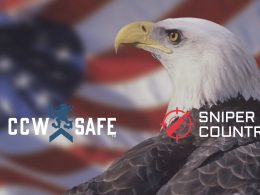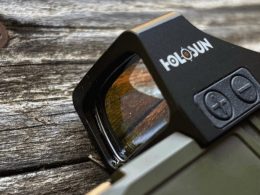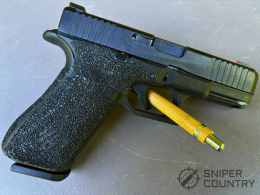In this Article:
An article about revolvers? Do they still make those anachronistic hunks of steel? Are they still relevant in this day and age of striker-fired, polymer-framed semiauto wunder-guns?
Ja, sure!
There are some shooting tasks that only revolvers can accomplish. Gun design, metallurgy and technology have advanced in the world of the wheelgun as well as the semiauto, and there are some great examples of the revolver designer’s talent and skill out there.
There have been hundreds of articles written about mainstream revolvers that most gunners have either heard of, owned, or shot. I’ve written several of them myself. But what about those guns that may not be on everyone’s radar screen? What about guns that you may not have seen? Those, and some of the old stalwarts, are the guns that I want to address in this article. Most revolver shooters know about the S&W 686s, the Ruger Super Blackhawks, the SP101s, etc. You may have heard of some of these guns, but maybe not all of them. So, let’s get started by looking some advantages that revolvers have over semiautos.
Revolver Advantages
Versatility. A huge advantage of the revolver over the semiauto is that they are very versatile, especially if you reload. I can make loads for my .357 that would put a deer down within reasonable ranges and then turn around and make “pussycat†target or small game loads. I killed a squirrel with my six-inch .357 with a load that I wouldn’t try to use on deer.
Safety. Another advantage the revolver has over the semiauto is that you can tell at a glance if it is loaded. A quick (safe) peek at the cylinder front tells you if the gun is ready to go. No loaded-chamber-indicators, no press-checks…just a peek. Notice I said “safe†peek – you can tell if a revolver is loaded without getting near the muzzle.
Simplicity. For double action revolvers, just pull the trigger and it fires…if not, pull the trigger again. No slide to rack or magazine to seat. Unless your pistol has double strike capability, there is a drill for clearing the chamber, etc. With revolvers, just pull the trigger again. Another factor is that revolvers can be easier to work on than semiautos…the designs of most common revolvers have been around for over 100 years and are well-known to most gunsmiths.
Reloading Test Bed. If you are new to reloading, be aware that revolvers are great as a test bed for loads. If you’re an experienced reloader, you most likely already know that. If you’re new to reloading, you may want to check out this article for some how-to advice. As mentioned above, all sorts of loads are shootable in my wheelguns that wouldn’t function a semiauto. This does not even take into account the many different types of bullets that revolvers can use. An example…I have a couple of self-loaders that only function with certain types of bullets. Since there is no feed ramp on a revolver, I can use anything from a full flat wadcutter to the latest and greatest jacketed hollow point and still have the gun go “bang†every time. Granted, bullet sizing, forcing cone and chamber throat dimensions are important but by and large most any revolver will shoot most any load designed for it.
More On The Versatility Of Reloading For Revolvers
I can’t remember how many times I’ve had to really fine-tune loads for my 9mms and .45s in order to get them to function properly. In the semiauto’s defense, once a load is found that is accurate and reliable, I stick with it because it will continue to work as desired with no further tinkering. There is nothing wrong with factory ammo, and revolvers do shoot it well…it’s just that I can shoot about 3-4 times as much for the dollar by reloading over buying factory ammo. One area that I do use factory ammo is self-defense. I always carry factory self-defense ammo in my concealed carry revolvers, not my reloads. I use my loads for practice and hunting.
The Cooking Analogy
For my revolvers, I use loads I’ve used for years or will experiment, like a baker trying a new cake. I’ve had to come up with some new “recipes†due to the fact that I cannot find Alliant powders around here – only the Hodgdon family is available. This is not a problem – I just swap powders, bullets and charges according to a reliable reloading manual, or to carry the comparison further, a reloading cook book. It helps if you think of it like that.
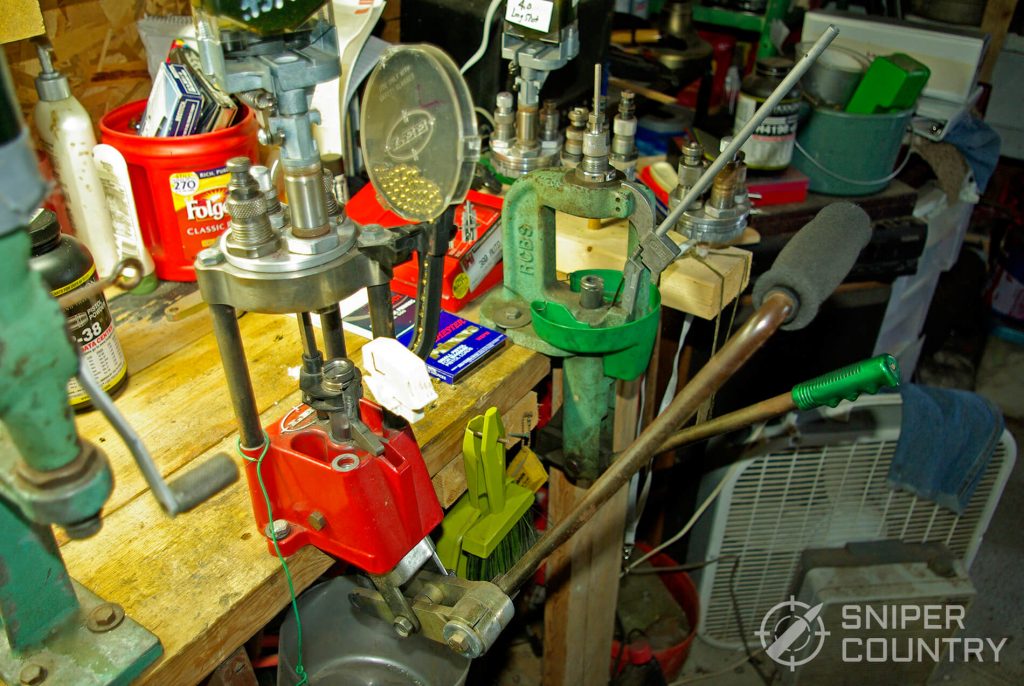
Just as there are those cooks who won’t turn the oven on without opening at least one cookbook, there are revolver reloaders who follow only data published by legitimate companies such as Hodgdon, RCBS, Sierra, etc. To go to the other extreme, my grandma would go into the kitchen and whip up wonderful meals (especially her six-inch-tall yeast rolls) without even knowing where the cook books were kept. She’d been cooking so long she knew her ingredients and proportions and the results were great. The simile applied to reloaders is the same…some guys have loaded, say, 7.5 grains of Unique with a 240-grain bullet in .44 Special for 50 years and they don’t need a reloading manual to do that. It all comes down to experience and familiarity. But…if you want to try something new, PLEASE use a reloading manual. Information off the internet (unless you’re on a bullet maker or powder manufacturer’s website) can be sketchy and sometimes downright dangerous. Revolvers are great for experimentation but be safe about it.
A New Revolver Recipe?
Here’s a good example of the versatility of revolvers and new loads. This Christmas I received a Lee .44 caliber bullet mold that throws a 240-grain (237 from my alloy) semi-wadcutter with tumble-lube grooves. This is a standard weight for the .44 Special and Magnum but I’d never had a mold that size. My original two Lee .44 molds are very old – one throws a 255-grain SWC and the other a 215-grain SWC – and both are single cavity molds. They were procured in the late ‘70’s, way before Lee made their excellent tumble-lube molds. I’ve killed many deer with the 255-grain bullet, but I’m anxious to try some new loads with the new 240-grain SWC. I should be able to get a little more velocity with that bullet without raising pressures. That just reinforces one reason I like revolvers – the ease with which you can experiment with new loads. Do I experiment with semiauto loads? Sure. I just have to ask myself the following questions that don’t get asked when I’m loading for wheelguns:
- Will the bullet feed in this particular gun? I’ve had trouble feeding .45 ACP semi-wadcutters in a Glock 30 – it didn’t like them, and I gave up. I now have a Springfield XDM compact .45 that eats SWC bullets with regularity – I’ve written about these guns elsewhere.
- Is the powder type and charge correct for this bullet weight and required velocity? This applies to revolvers too, but is more critical with semiautos. That same “mouse load†I can shoot out of my .357 Magnum may not even provide enough pressure to cycle a semiauto’s slide with an equivalent semiauto load.
- Is the bullet diameter correct for the semiauto’s chamber? Revolvers tend to have a tiny bit more leeway where this is concerned. A mitigating factor for both types of guns is that the new Lee molds produce bullets that are not meant to be sized. I’ve had pretty good luck shooting these bullets “as-is†but a semiauto can be picky, according to its chamber dimensions, especially headspace. An example: I just acquired a new Taurus G2C 9mm (an excellent buy, by the way) with a tight chamber. The cartridge overall length must be shorter in order for them to feed in this gun. It’s no big deal, but a with revolver OAL only matters if the bullet nose sticks out of the end of cylinder far enough to prevent rotation. Small OAL differences usually aren’t important with revolvers.
Again, these are just examples from my experience but they give you an idea about the differences loading for both types of guns.
Why Spend So Much Time On Reloading?
My point in mentioning all this is that it is easier to experiment with new loads with a revolver than a semiauto (at least it has been for me). You get immediate feedback (if a cartridge hasn’t been assembled properly it probably won’t fit into the cylinder chamber). Also, with a revolver you don’t have to worry about bullets failing to feed into the chamber of a semiauto when the slide slams home due to being the wrong size or configuration, or other reason. As a reloader, I love my semis, but I’m not about to sell off my wheelguns.
BONUS OFFER: Get your free shooting range targets to print at home!
Get your free targets to print at home!
What Defines A Good Revolver?
There’s a topic that you could write a book about, and many have been written. I have already written several detailed articles on this site that cover the best .22 pistols (I mention some revolvers, too), the best concealed carry revolvers, the top ten .357 Magnum revolvers, and the best .44 Magnum revolvers. If you are interested in a more in-depth look at any of these guns, please check out the linked articles. Our problem will be narrowing down the list of guns we discuss for this generalized overview. I cover the mainstream guns in the articles mentioned above.
I will attempt to do an overview of those revolvers that I consider to be the best at fulfilling a specific need and may not be the first gun that pops into your head when someone asks about a good .357, or .22, etc. So, we need to limit our scope to certain categories and keep the number of revolvers mentioned down to a manageable number. As stated, some of these guns are off the beaten path a bit but all represent a good value in a wheelgun. I know these guns first-hand and have had great experiences with them. Let’s define our categories.
Calibers: What Are The Most Popular Revolver Chamberings?
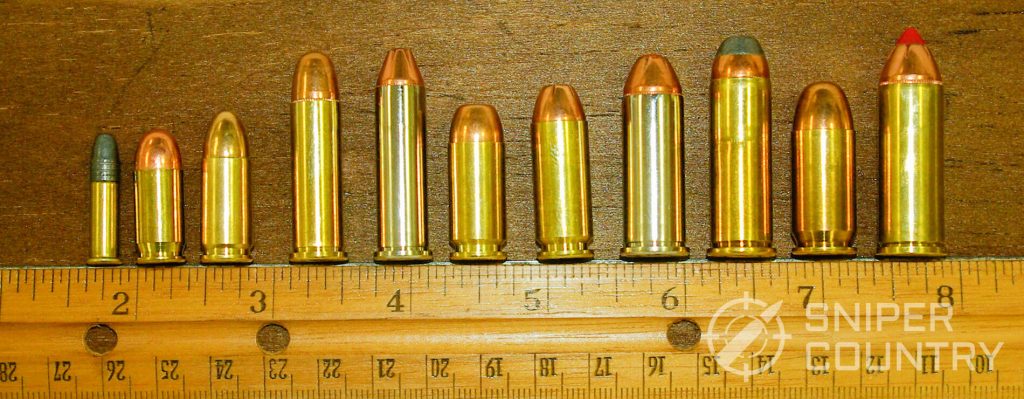
We will narrow our discussion to the most popular, best-selling revolvers chambered in the following calibers:
- .22 LR
- .38 Special
- .357 Magnum
- .44 Special
- .44 Magnum
- .45 Colt
These are the calibers that most revolvers made are chambered in. To be sure, there are many others and I don’t mean to slight those shooters who love their .454 Casulls, .480 Rugers, .500 S&Ws etc. but I’m trying to keep the article concise while at the same time talking about guns that you could buy ammo for in most gun shops and big-box stores. The larger moose-stompers have their place, but for now we’ll stick with what I call my “Big 6â€.
Read also: My Handgun Caliber Guide
Double-Duty Magnums
One thing you will notice is that there is some overlap in terms of what I call double-duty guns…the .357 Magnum and the .44 Magnum revolvers will shoot the .38 Special and .44 Special, respectively. I will keep the Special cartridges on the list, though – they are still viable chamberings. I could make our gun list shorter by just talking about magnum revolvers, but there are a few Special-only-chambered guns in both calibers that are interesting and I will mention them.
Categories…How Will We Use Our Revolver?
Revolvers are very versatile handguns. They can perform many tasks well, some tasks better than semiautos. So, how do we decide which categories to include? Here’s where I rely on my 40-plus years of experience with wheelguns. Some are better than others at performing specific shooting-related tasks. We will look at the best revolvers for:
- Hunting
- Plinking/Fun Shooting
- Competition
- Concealed Carry
- Home Defense
We will look at one or more guns in each category…obviously, there will be some overlap. For example, that S&W .44 Magnum that you strap on your hip each deer season would most likely make an excellent target or home defense gun (with appropriate loads). There will be a few overlaps but by the end you should have at least a starting place in your search for that special revolver. That’s the goal of this article – to make you aware of what’s out there and to give you some basic information as to usage, caliber, barrel length, etc. so you can make an informed decision. I will also try to break down each category a little further by mentioning a budget gun and a higher-priced sample for each section in order to hit most everybody’s budget point. Let’s get started by offering some definitions about revolver action types so that if I mention “double action†or “single action†you’ll know what we’re talking about.
Types Of Revolvers
In a single action gun, the hammer must be physically cocked in order for the gun to fire. Picture the Old West’s Peacemaker Single Action Army…shooters back then got really good at cocking the piece as it cleared leather. I guess they had to be good at it, or else.
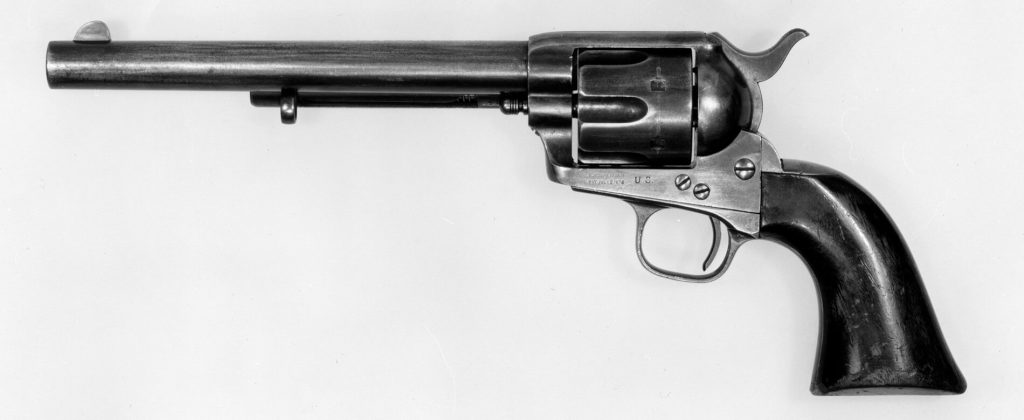
The double action revolver first made its appearance in 1877, according to my research. Colt introduced its double action Thunderer in that year in several calibers. The following year found that gun chambered in .45 Colt, the standard-issue cartridge of the single action Army revolver.
The double action revolver can be fired by either manually cocking the hammer like the single action (which usually yields a somewhat lighter trigger pull) or by simply pulling the trigger which both cocks and fires the gun. Hence, two ways of firing the gun.
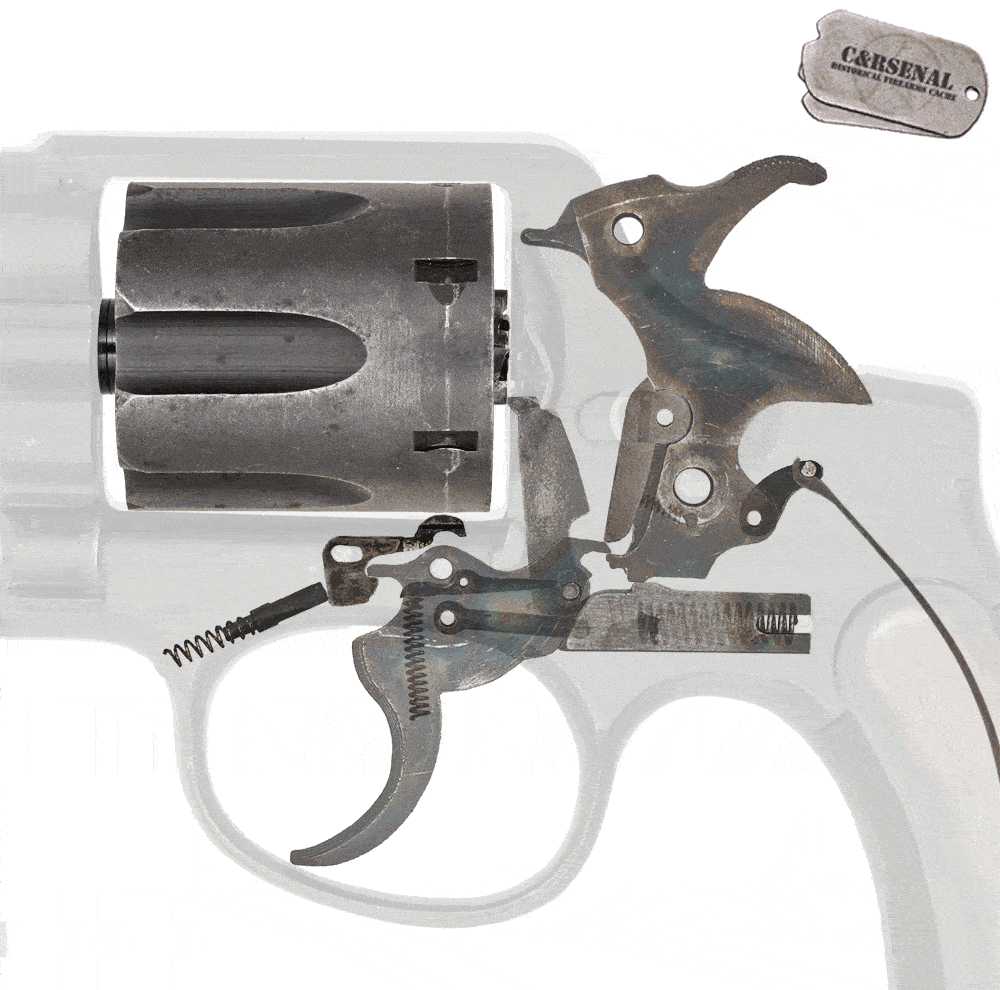
So, to define “double actionâ€, it simply means that, with by just pulling the trigger, you perform two actions – you both cock and fire the gun without having to first manually cock the hammer as you do in order to fire a single-action gun. The double action gun can be faster to get into action since you don’t have to thumb a hammer back. The double action revolver was the military/law enforcement handgun of choice for many decades and is still going strong today. Let’s look at some guns and their typical uses.
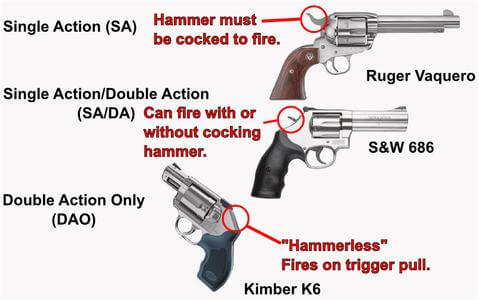
The .22 LR Revolver
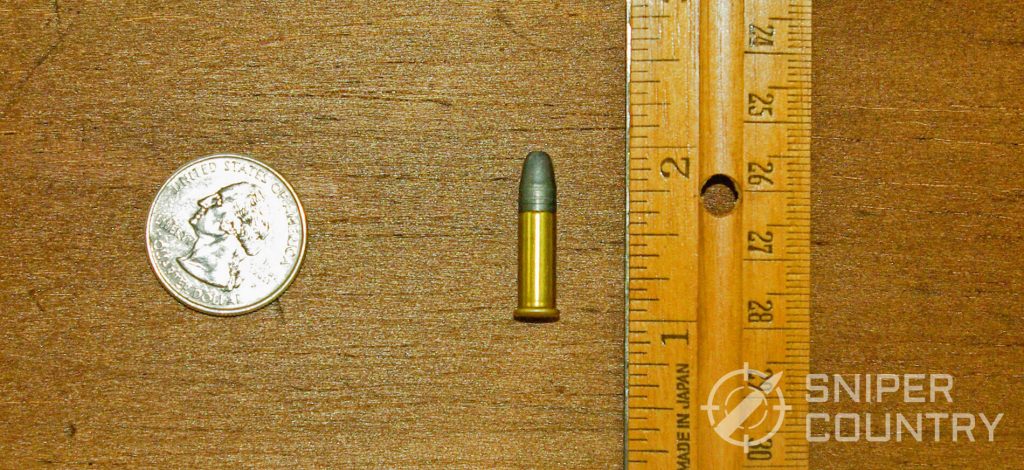
Uses: Plinking, Hunting
Some of the best .22 LR revolvers are very affordable and accurate. Accuracy with any .22 gun, rifle or handgun, depends upon your finding the brand of ammo that your gun shoots best. I have a Heritage revolver that likes plain CCI Mini Mags, while my Ruger 10/22 like Aguila. You just have to experiment.
Heritage Arms Rough Rider
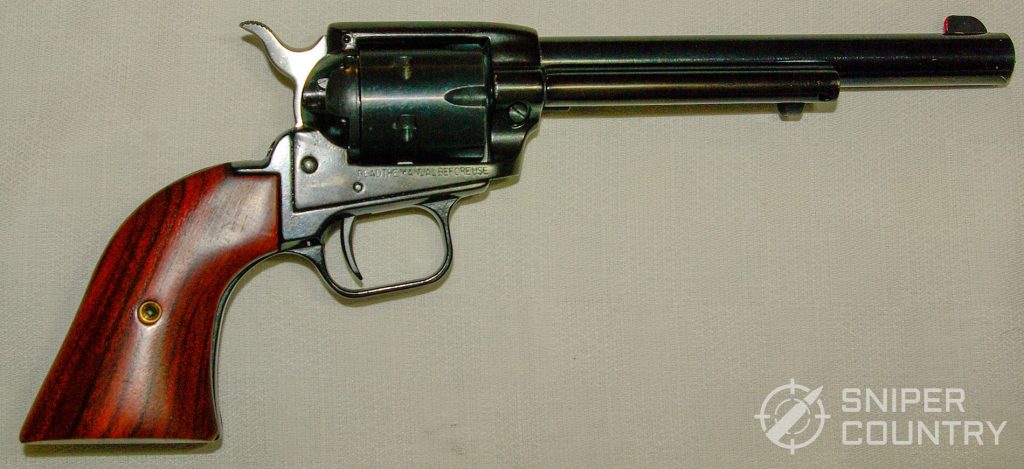
One gun I like to take into the woods with me when I’m out and about is my Heritage Arms RR22 revolver. This gun is inexpensive (you can find them for around $150 usually) but, given the right ammo, they can be accurate. This gun is at home in its role as a plinker, but if given the right ammo can be a decent small-game gun as well. As I stated, I had to experiment a lot before I found one type of ammo that the gun liked. These guns come in barrel lengths between 4.75 and 6.5 inches. The longer barrel would be indicated if you are going to use yours for hunting, as it helps develop a little bit more velocity (but not a whole lot with the .22LR). The main advantage is the longer sight radius provided by the 6.5-inch barrel. But, if a short barrel and grip are what you want, there are models with cocobolo bird’s head grips and 4.75-inch barrel.
Safety
This is the only Peacemaker-styled single action revolver I know of that has a safety lever. It’s on the left side of the recoil shield, at the top.
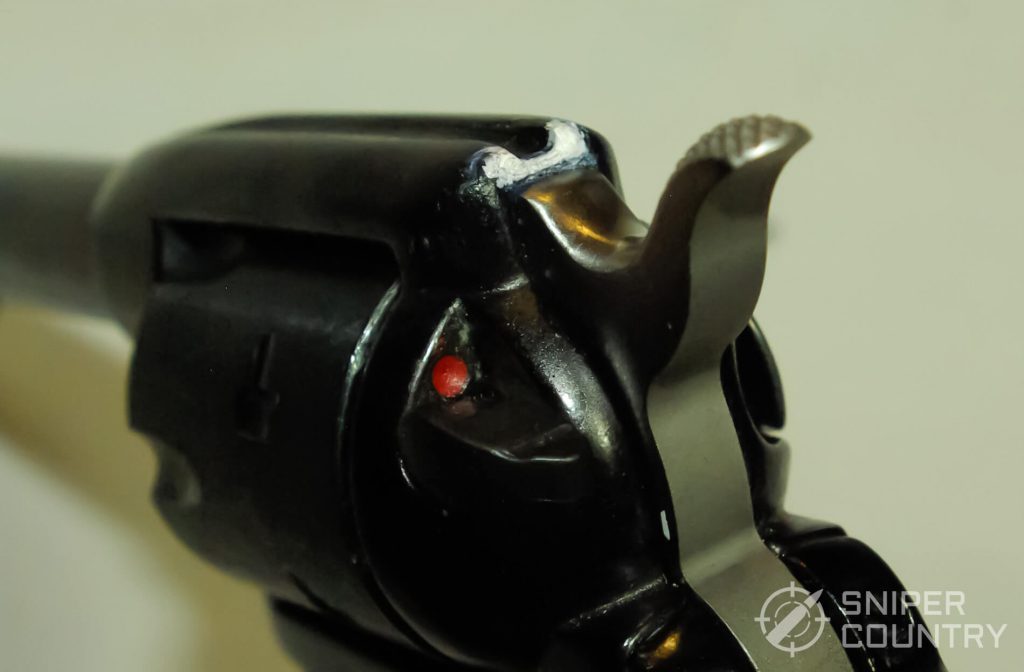
When moved so that the red mark is visible, the gun will fire. Otherwise, when on safe it blocks the trigger from touching the frame-mounted firing pin. This lever is unique for a single action gun, and makes this gun a viable training aid for beginning shooters. Interestingly enough, some folks who own these guns will engage the safety and then practice dry-firing. There is no handgun maker who makes a rimfire gun that I know of that recommends dry-firing, due to possible damage to the firing pin, chamber mouth or hammer. The Heritage safety transfer bar blocks the firing pin, so the flat-faced hammer hits it instead of the firing pin.
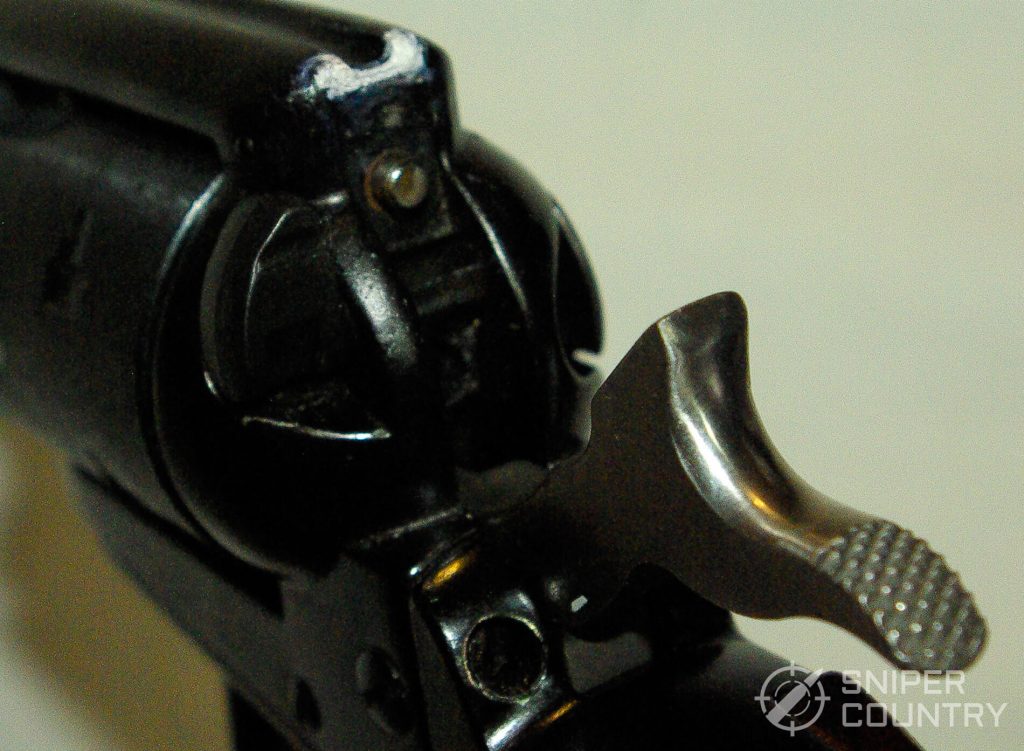
All Heritage Arms .22LR pistols are called model “RR22â€, to the best of my knowledge. (The “RR†stands for Rough Rider). I have a lot of experience with this brand, not only because I’ve owned more than one but because I do the updates for a local gun shop’s web site inventory page and that shop sells a lot of these guns. They come in the above-mentioned barrel lengths and are finished either in a matt blue or a more polished version. Grip panels can be anything from actual rosewood to the latest I’ve seen, brown pearl (resin, of course, although it IS rather nice looking – I thought it was polished walnut). There is even an American flag grip motif in both barrel lengths.
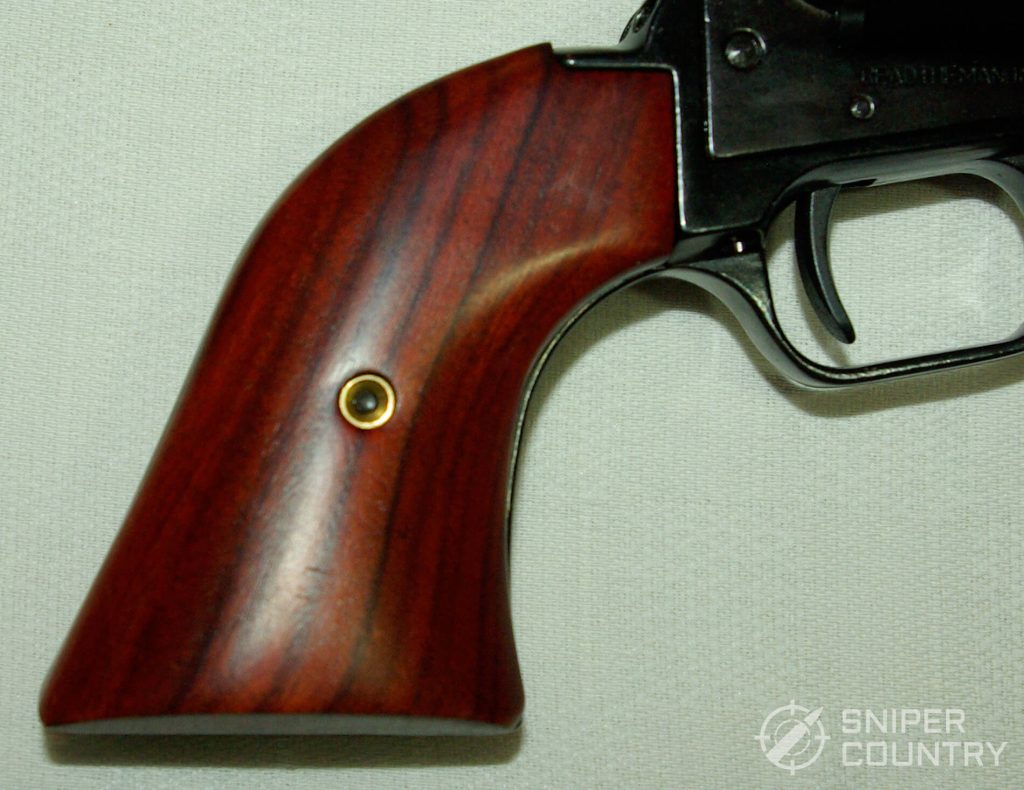
.22 Magnum. Anyone?
Another feature this company offers is that, for about $25 more added to the gun’s price, a fitted .22 Magnum cylinder is included.
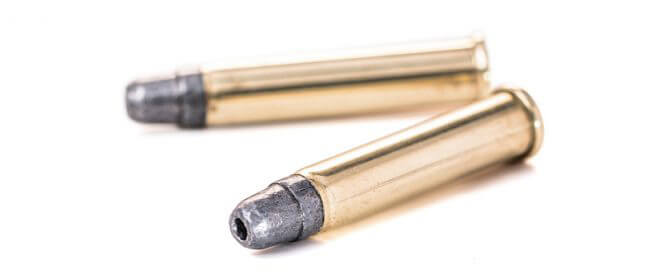
Now we’re talking! This lengthier version of the .22LR is a definite hunting round. This is another plus the .22 revolver has over its semiauto cousin. Other companies that sell .22 revolvers may include a second magnum cylinder but may be priced out of the range of a beginning shooter on a budget. A word of warning – don’t be lazy and just use the magnum cylinder. The long rifle cartridge cases will most likely split, since chamber dimensions are not the same between the two and less-than-pleasant things can happen when a case ruptures. Use the correct cylinder.
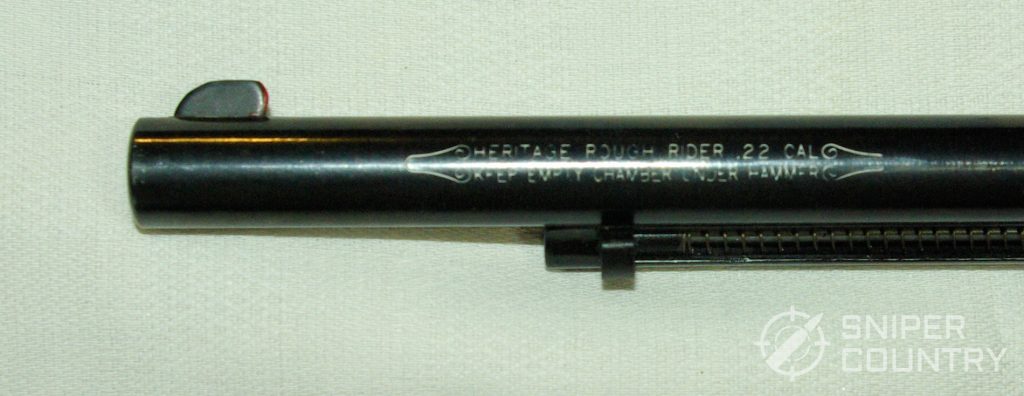
If I Could Change One Thing…
If I could change just one thing about these guns it would be the sights. The old Peacemaker “topstrap-groove-rear-and-half-moon-front” system worked well in the 19th century but I want a little more.
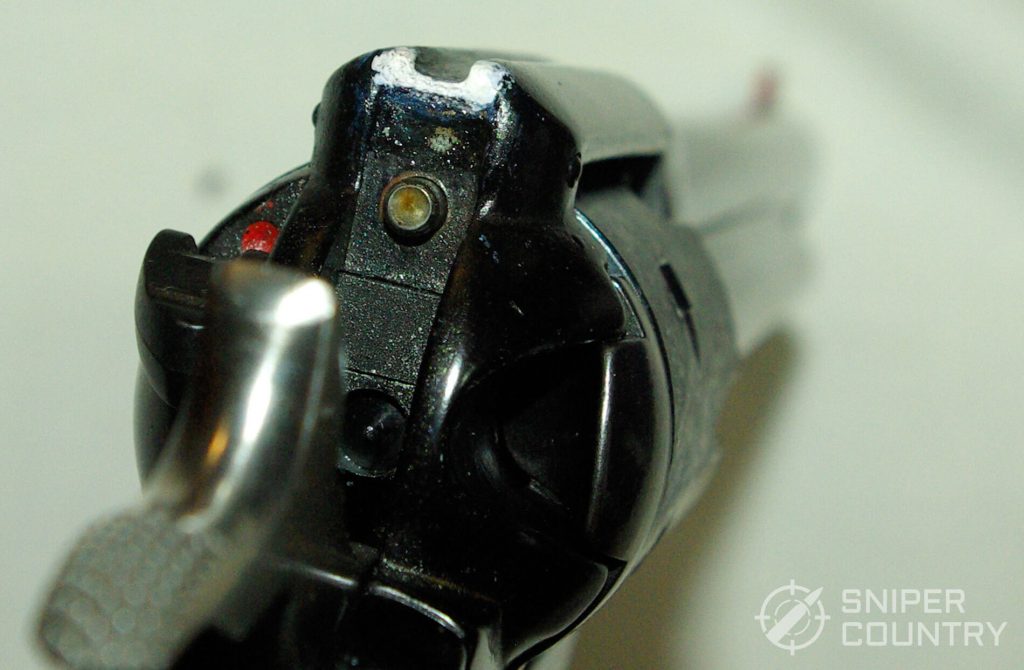
I altered my sights, as the photos show – first, since the rear was not too visible, I filed a square notch more in keeping with traditional fixed rear sights. I then found the brand of ammo that it liked and, since it consistently shot low, I filed just a little off the front sight to raise the groups on the target. A coat or two of paint topped it off. The results aren’t pretty but they work. I am shooting with a little more precision due to the adjustments I made. These “fixes†are not hard to do, but remember…if you go too far with either sight, you can’t put metal back without welding and a small error in filing could equal a big error downrange. Don’t be afraid to try it, just go slowly. After all, we’re not whittling metal off the front sight of a rare second-generation Colt Single Action Army…if you make a mistake, you’re not out much.
All in all, if you want a .22LR (and possibly Magnum, depends on the exact model) revolver that won’t break the bank, give the Heritage Arms guns a look. There are many models to choose from. They also make larger-caliber pieces in .45 Colt, so they know what they’re doing. Another plus is that the company has been owned by Taurus since 2012 and the guns are made in Opa Locka, Florida. I could find no MSRP on the Heritage Arms website, but these are popular guns and I’ve seen them around here anywhere from $130 to $175. They are a decent buy.
Ruger Single Six Convertible
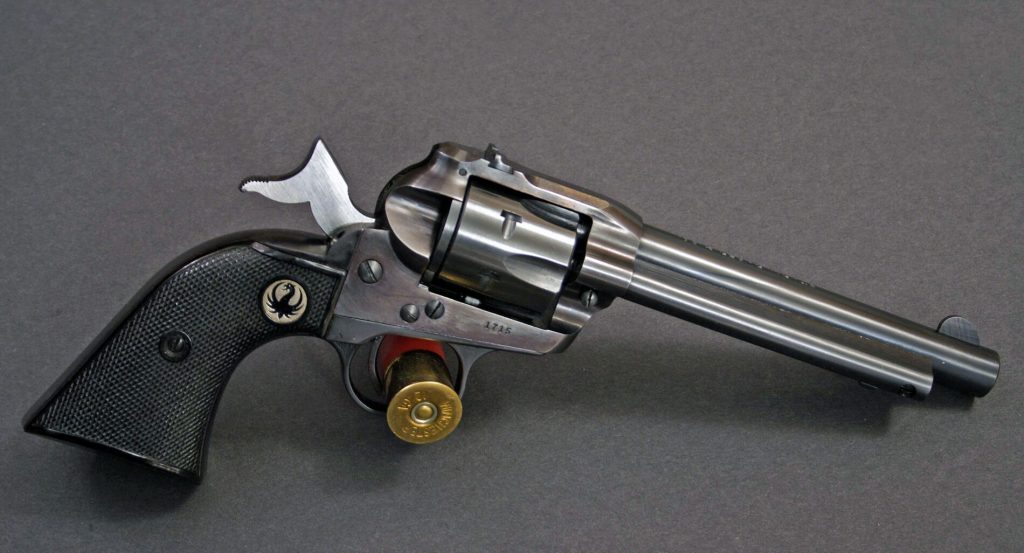
If you are looking to spend a little more on a single action .22LR revolver, look no further than the Single-series guns from Ruger. These guns are available with a variety of features. First, if you just want to cut to the chase and buy a .22 Magnum, they make a couple. Barrel lengths range from 4.62- to 9.5-inches (long barrel in blue only), with either blue or stainless finishes offered for the shorter barrels. Ruger’s tough adjustable rear sight comes with all of them except one, and a .22 Magnum cylinder is included. The stainless models utilize Ruger’s nicely-figured hardwood grip panels, with the blued ones having the black plastic panels.
I owned a 4.62-inch blued specimen once a long time ago. I took a squirrel out of a fork in a tree offhand at about 35 yards – both my brother and I remember that shot – so I know they are accurate. I mention this only to reinforce the fact that barrel length has nothing to do with the gun’s built-in, intrinsic accuracy. The shorties shoot just fine and are easier to pack. The advantage of the longer 5.5- and 6.5-inch barreled guns is a bit more velocity (though not as much as we’d like to think) and a longer sight radius.
If you want the traditional six-round cylinder, it’s there but if nine is more to your liking, that’s available as well as the Single Nine. Either will perform well at the range or in the woods. MSRP ranges from $629 – $699; expect to find a new Single Six locally from about $480 to $550, depending on finish and features.
Ruger GP-100 .22 Revolver
Doesn’t Ruger only make a .357 GP-100? Nope. They also make a .22 (and a .44 Special, but that’s later). This 5.5-inch-barreled, 10-round-capacity double action revolver is made to Ruger‘s exacting standards. Weighing in at 42 ounces, this is probably not the gun you strap on for a leisurely walk in the woods, but it would make a dandy small game hunting piece. With the GP-100’s features such as a fiber optic replaceable front sight, rubber/wood grip, stainless finish and excellent adjustable rear sight, this gun is a great example of a .22 that you could use as a trainer for its bigger .357 Magnum cousin.
I’ve gone on and on in my other articles about how I really like the way Ruger over-builds its guns…if you’ve read any of them, you know that I am a huge fan. The “lowly†.22LR GP-100 is no exception. It is built just like its .357 Magnum stablemate except the holes in the barrel and chambers are smaller, to use technical terms. If you are looking for a bug-out gun that will hold up and not give you any problems, this might be it. You can carry a whole lot of .22 ammo versus the larger-caliber stuff.
For a .22LR revolver built on a large frame, you can’t beat the GP-100. MSRP on the 5.5-inch-barreled version is $829, but I’ve seen them for around $650 or so.
Popular Articles
The .38 Special Revolver
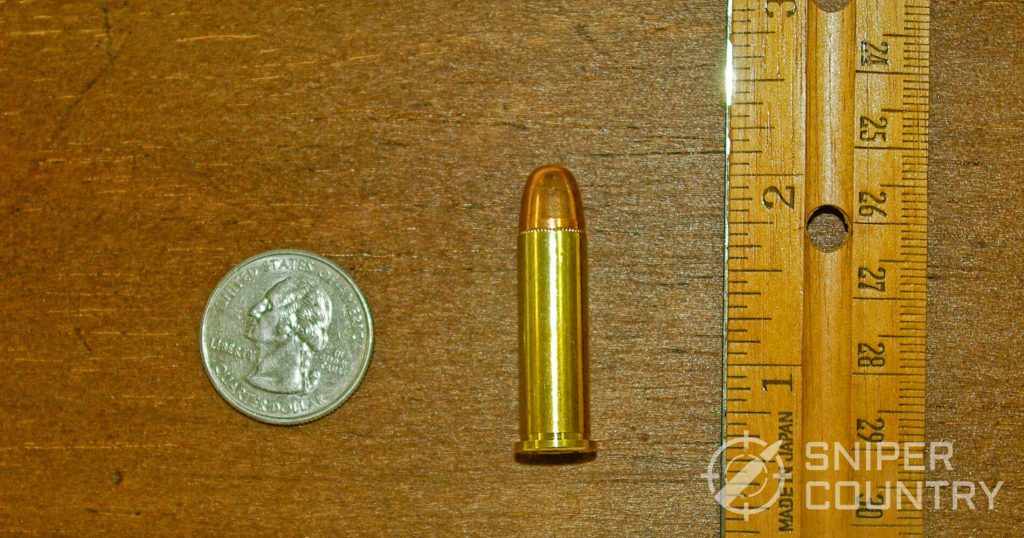
Uses: Plinking, Competition, Concealed Carry, Home Defense
The old-fashioned .38 Special. has been one of, if not the most, popular revolver rounds for years. Introduced in 1899, it has grown to be probably the most reloaded revolver cartridge going and shows no signs of waning. Truly a versatile cartridge whether shooting reloaded ammo or factory stuff, the .38 has filled many roles over the years. The most notable of its many uses has been in law enforcement. For decades, uniformed police carried a S&W Model 10 or Colt Police Positive in 4-inch form. The loading of choice back in the first part of the 20th Century for police was a 158 or 200-grain lead round-nose bullet traveling at about 800 fps. (It’s hard to tell, but I do believe that Barney on the “Andy Griffith Show†carried just such a round in his shirt pocket…details are important!).
It was only after criminals became motorized in the 1930s that the F.B.I. and local agencies clamored for something more able to stop the bad guys. Some experimentation was done, using a S&W Heavy Duty .44-framed gun. This testing led to the .357 Magnum, which appeared in 1935. A lot of people said, after that big boomer came out, that the .38 Spl. was dead. We now know they were wrong. According to a list compiled by RCBS in 2012, the best-selling revolver dies were for the .38 Spl/.357 Magnum (you can use the same dies for both).
Why Is It So Popular?
The .38 Spl. is a versatile round. Whether you are competing and shooting either paper or steel targets, carrying a gun while woods walking, informally shooting for recreation or carrying a snub-nosed revolver concealed, the .38 can do all of these and do it economically. When loaded with proper modern bullets, the old .38 can shine as a self-defense round. Even folks who own a short-barreled .357 Magnum that they carry will usually load it with .38 Spl. +P ammo – it can be that effective. The .357 Magnum, in a small package, can easily get to be “too much of a good thing†– the recoil and blast are awesome. Hence, the use of .38 Special rounds. Here’s a look at my favorite .38 Special line of guns.
The J-Frame S&W
(This will be the only gun I’ll discuss chambered specifically for the .38 Special, since all .357 Magnum revolvers will fire the .38 and I have a couple of .357 choices that might be a better buy since they’ll do double duty).
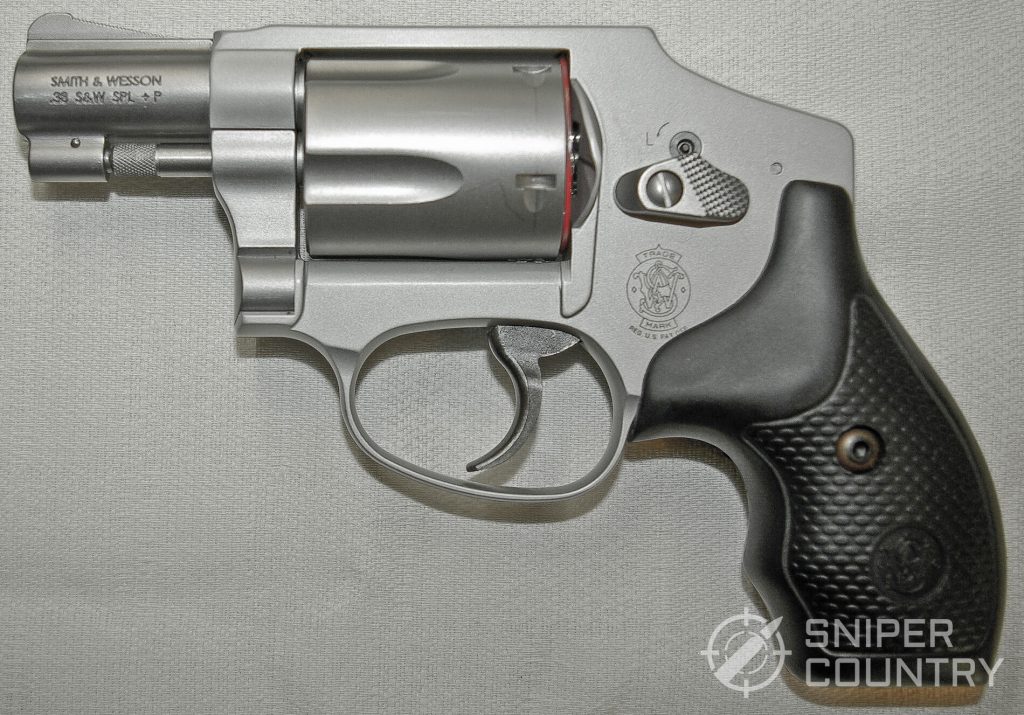
The J-frame is a very popular choice these days in a carry .38. Here we have a snub-nosed revolver that disappears in your pocket, if you like that mode of carry. Notice I didn’t mention a specific model as there are dozens of models and variations of guns made on the smallest frame manufactured by S&W – the J-frame. The best-selling model right now is the 642. This is an Airweight gun with a 1.87-inch barrel that has an enclosed hammer. There is no hammer spur to snag on the draw. My personal J-frame is a Model 638, a similar gun in size and weight but it has an exposed hammer spur tip. The frame is built up to shield the bulk of the hammer, but you can still get a thumb on it if you want to cock the gun for a single action shot. I have a Laser Lyte laser on mine – lasers are easily mounted on these guns.
If you’re looking to stick a gun in a pocket holster and just let it ride there all day, a J-frame should do that just fine.
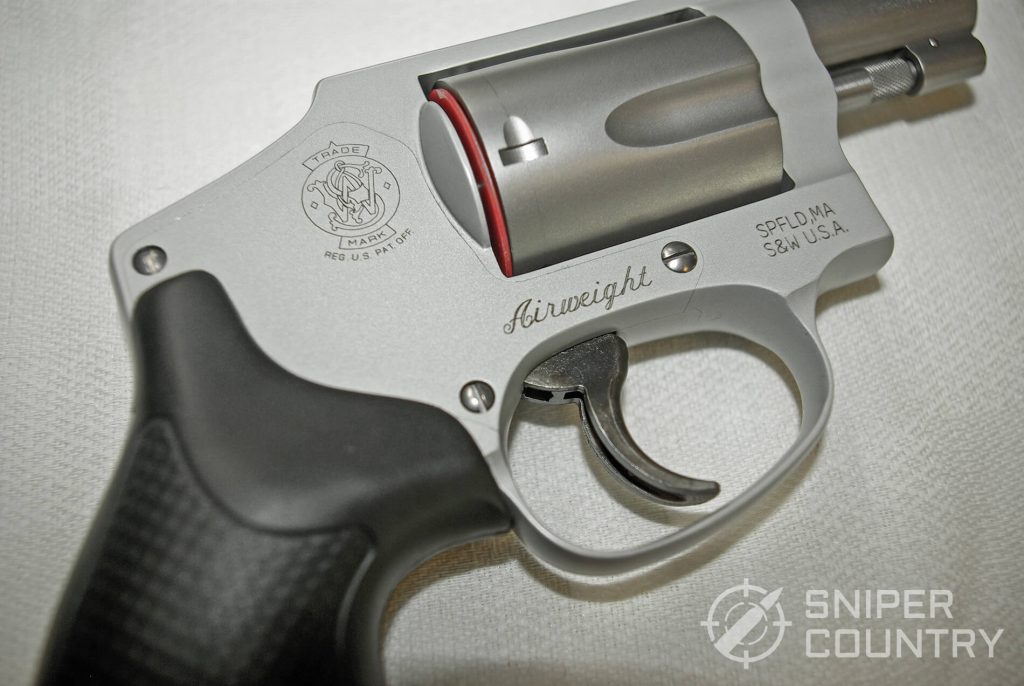
What is amazing is the variety of these guns that S&W makes – if you don’t want an Airweight, there are heavier versions available. Want a factory-mounted laser? No problem. The S&W site offers more than 50 types, models, styles, etc. of their ubiquitous J-frame, so surely there is one that would work for you.
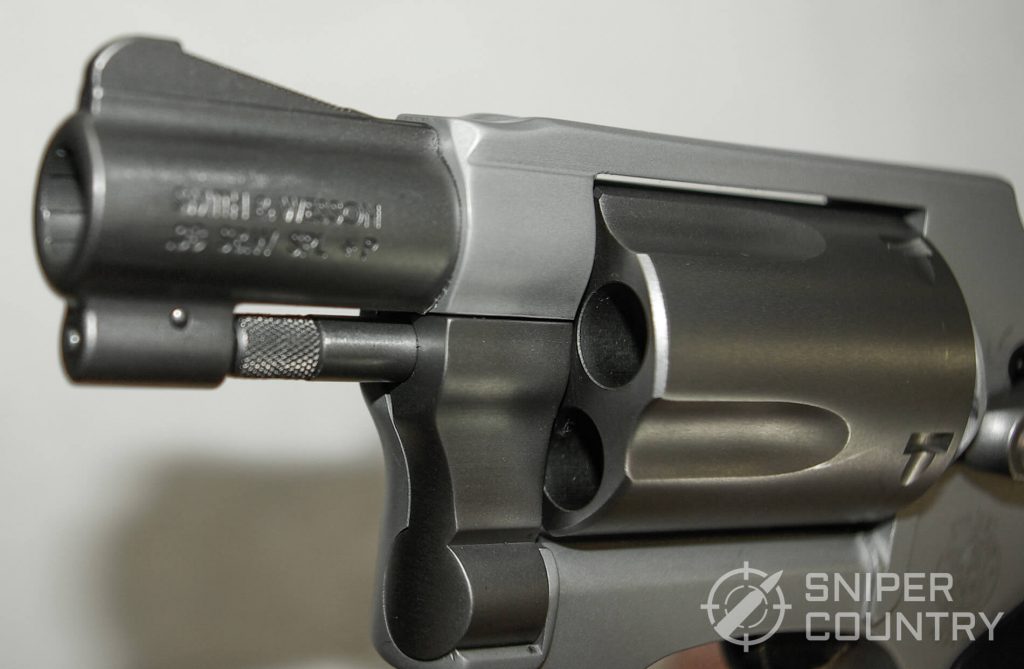
The guns are rated for +P ammo, also, and I know from experience that they will handle it. All styles of grip colors are available including pink – there are J-frames meant to be marketed to females. And, these guns are accurate! Don’t let the sub-2-inch barrel fool you into thinking they are only good at 10 or fewer yards…I’ve hit with some regularity a steel target at 50 yards with mine (no, it wasn’t an old Chevy…). This model is a good choice for concealed carry. There are .357 Magnum snubbies out there, but most guys I know that carry them load them with .38 Special +P ammo, which tends to be more controllable. I still think the J-Frames are king of the snubby hill in terms of sales. The MSRP on a Model 642 is $469, but a real-world price is closer to $400.
S&W Model 10
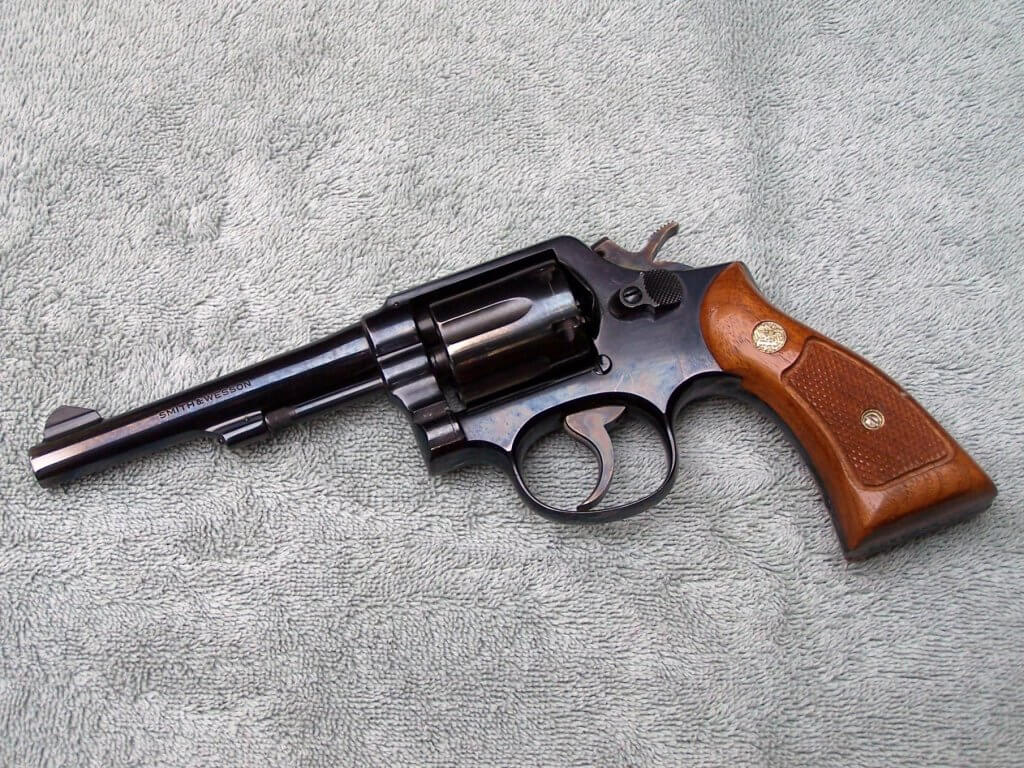
The S&W Model 10 revolver is the grandaddy of modern DA/SA revolvers. Brought out in 1899 as the Military & Police, this .38 Special was one of the first revolvers to be chambered in the then-new .38 S&W Special. It was made in great numbers and was also known as the Victory revolver when S&W produced thousands of that model for export to (mainly) Great Britain in their proprietary caliber of .38-200. This is one famous revolver. It was built on the mid-size K frame, which unfortunately no longer is in production. Matter of fact, the factory is making a throw-back classic based on that K frame – the Model 19. This is the .357 magnum that Bill Jordan pestered S&W to make. It became an instant hit, but that’s a different story. The Model 10 is a bare-bones .38 that defined the genre of mid-sized .38 revolvers. If you are looking for a well-built, plain-Jane .38 with fixed sights that just oozes history, give the Model 10 a look.
The .357 Magnum Revolver
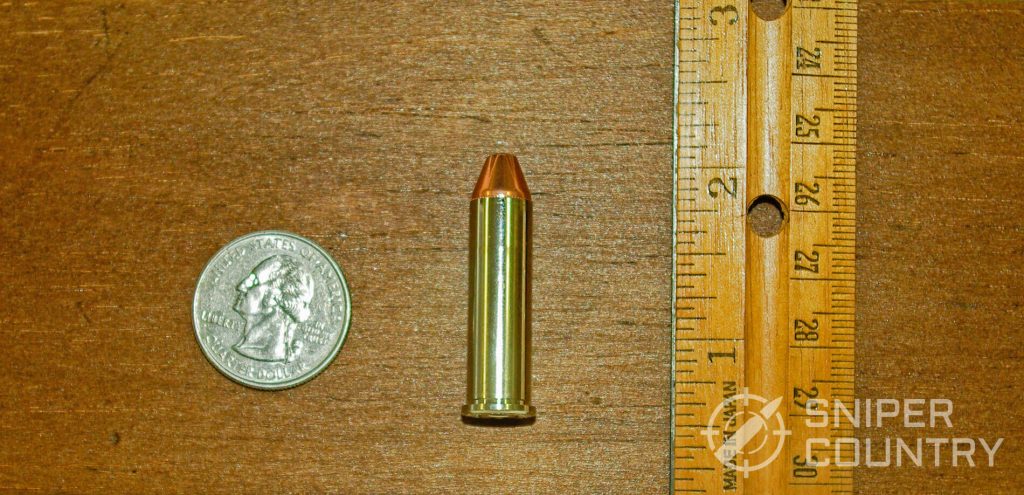
Uses: Hunting, Concealed Carry, Home Defense
As we move up the revolver “power grid†so to speak, we start getting into some very versatile, hard-hitting revolvers. Available in barrel lengths from two to eight inches or longer, some people feel that the .357 Magnum is THE best all-around revolver cartridge. From my own experience, being a reloader, I can vouch that it is a capable round for just about any use that you care to put it to.
Hunting
I can load the .357 up to top levels with a good Hornady 158-grain XTP JHP behind a stiff dose of a slow-burning powder and have an effective deer load out to 75 yards or so, and then turn around and put together loads that will take a squirrel out of a tree without turning him inside-out at bullet impact. (I have a photo I took as a joke that shows, like any good game trophy photo, the deceased game with a cartridge and the gun beside it). The point is that the .357 is that versatile. Of course, anything I do at my reloading bench is available tenfold with factory ammo. From deer to squirrel, there are loads you can buy to take game so don’t feel left out if you don’t reload.
The .357 And Law Enforcement, Self-Defense
The advantages of the versatile .357 shine through. From “barely-make-it-to-the-target” loads to moose-thumpers, the .357 will work. Perfected in 1935, the original load took a 158 grain lead semi-wadcutter to 1500 fps out of a long barrel. The F.B.I. expressed an interest in it for its ability to get inside a gang’s getaway car and take out the driver, or at least shatter the windshield which the .38 could not do. After a few years more loads appeared for the .357, ones that were effective out of a shorter-barreled gun. The 125 grain JHP is listed as one of the most effective loads of all for self-defense situations; the downside is that it hurts to shoot it out of a two-inch-barreled gun. I’ve seen data from a famous study about handgun cartridge one-shot-stop percentages that put the 125 grain .357 load at anywhere from 87% to 96%, depending on load and bullet. So, it is effective for that use but comes at a price with increased recoil and blast. A four-inch revolver is better than to two-incher in the recoil department, with a six-inch gun being the best for both recoil and controllability.
I’ve owned a few .357s over the years and can state, in general terms, my six-inchers were easier on me than the shorter-barreled ones. One four-incher in particular, a S&W Highway Patrolman was brutal in the blast department. It was heavy enough to soak up a lot of the recoil, being built on the large N-frame but the short tube was murder on my ears, even with protection. I now have a six-incher that is easier in both departments. I never shoot without ear & eye protection, in case you were wondering. Lessons have been learned.
Here are three guns to consider…
Taurus 66 6-inch
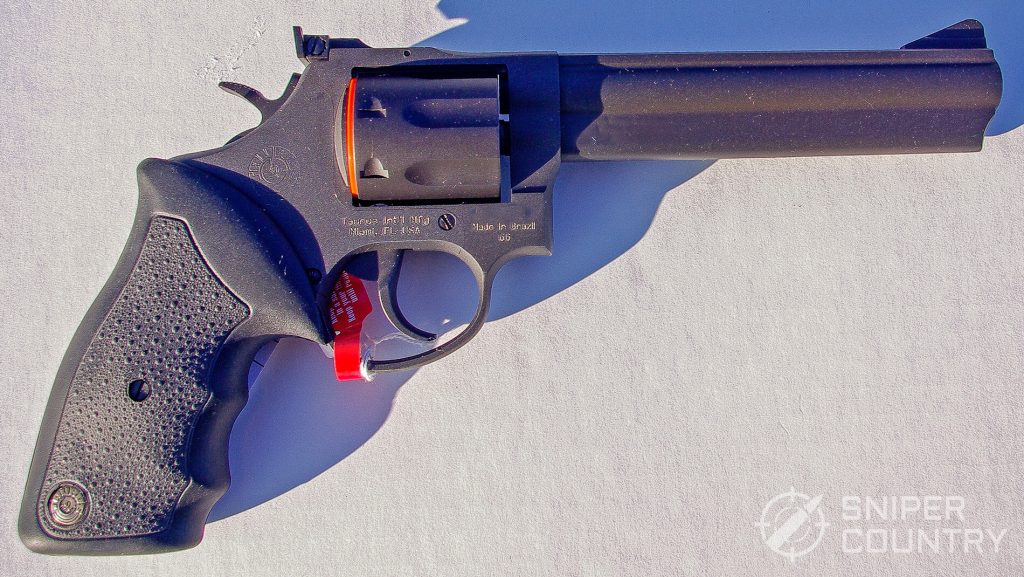
The Taurus 66 is a good buy in an under-$400-or-so street priced gun. One bonus is that it has a 7-shot cylinder. I’m writing about the 6-inch version, but shorter tubes and stainless finishes are available. The 66 comes with a lifetime warranty and a year’s membership in the NRA, two bonuses.
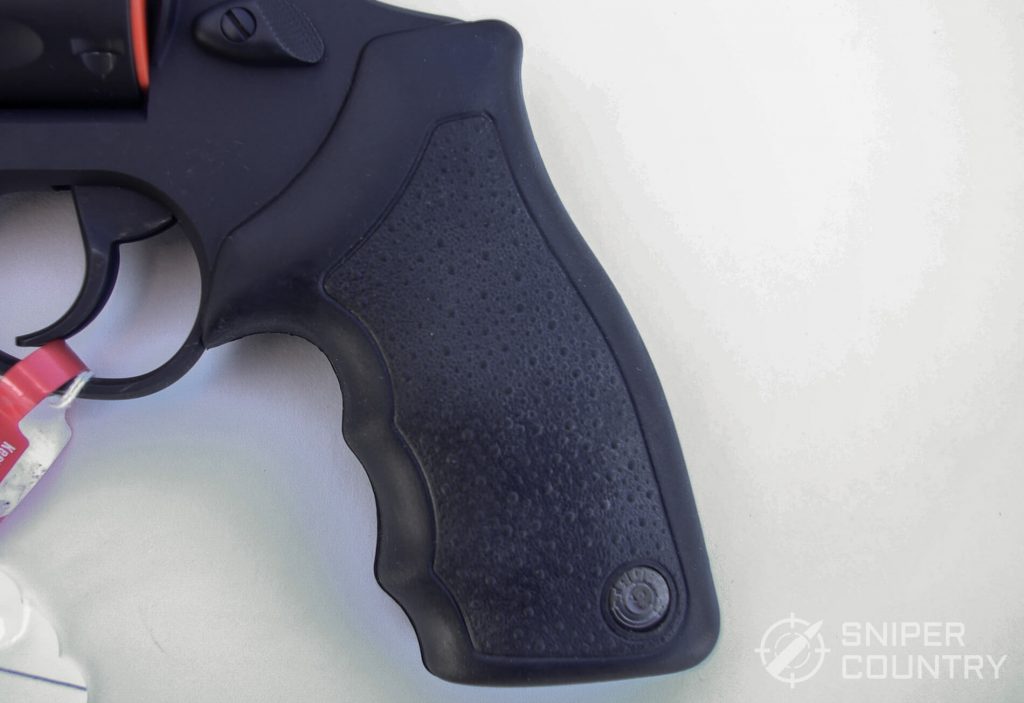
How Many “66s†Are There?
As you scan to the next gun, you’ll notice that it is a S&W Model 66. Same model number as the Taurus. Is that a coincidence? For several years, both S&W and Taurus were owned by the same parent corporation and shared technology, tooling, designs, etc. Taurus could legally build revolvers that looked a lot like those from S&W. The original S&W Model 66 came out in the 1960s as a stainless variation of the popular Model 19. Taurus simply tagged its mid-framed-357 with the same model number since the guns shared some features and were similarly sized. So, it can be confusing keeping the correct “66†with the right company, but the guns are worth the trouble.
Taurus sometimes gets a bum rap for its quality control procedures but I’ve had good luck with the many Taurus guns I’ve owned, and their revolvers seem to be a pretty decent value for the money. MSRP on the 40-ounce 6-inch in blue is $579, with the 4-inch version coming in at 2 ounces less and costing $543 (MSRP). Real-world pricing on the 6-incher should be a little under $400. It is available in stainless for slightly more. If that isn’t enough variety for you… if you don’t need a fully-adjustable rear sight you can get the blued model 65 with fixed rear sight (notch in the top strap) for an MSRP of $519, which translates to well under $400 at your local gun shop or online. This would make a great truck or utility gun…not a bad buy.
S&W Model 66 Combat Magnum
The 2.75-inch-barreled version of S&W’s relatively new Combat Magnum revolver series is a very popular gun right now. It does come with a 4.25-tube but the excitement is centered around its shorter- barreled cousin.
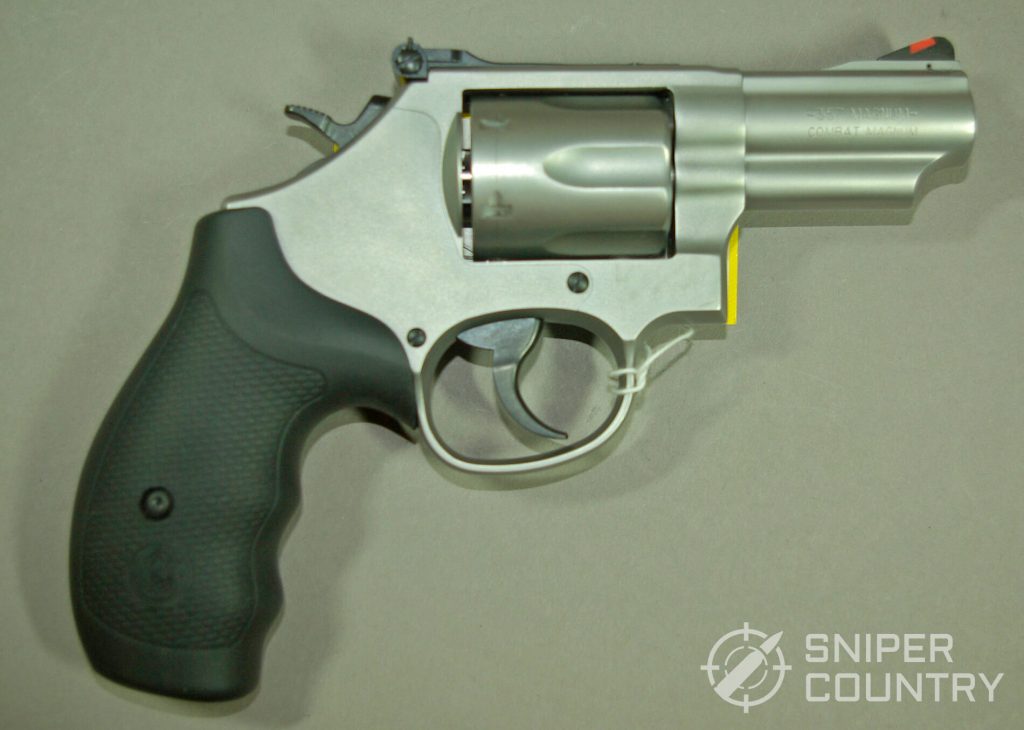
Why A Sub-Three-Inch .357?
I just finished talking about a couple of 6-inch guns, a very handy length for hunting or steels at 50+ yards but what if you just wanted a good-quality .357 to pack around the ol’ homestead that didn’t require a draw motion that puts the gun’s grip into your armpit? OK, I exaggerate a bit, but here’s your gun.
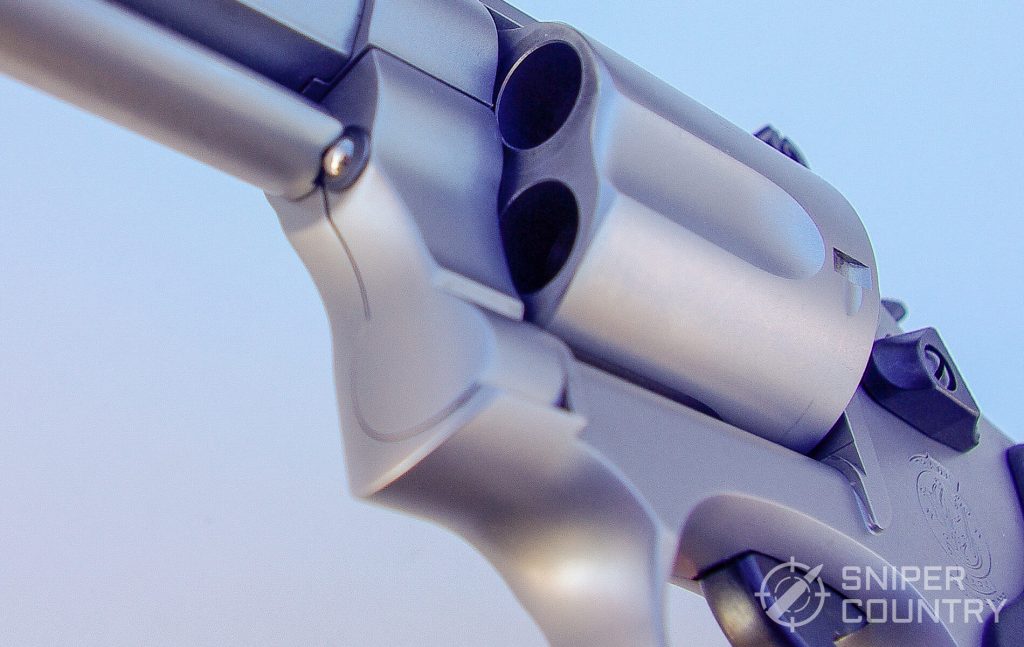
Built on S&W’s popular K-Frame, this 33.5-ounce boomer has many uses. Made of stainless steel with a matte finish, the barrel consists of the steel barrel itself and its shroud and has a full-length extractor rod and underlug. With sights, cylinder release lever, hammer and trigger “in the black†(finish), the gun is a looker. It does utilize the internal keyed lock system, love it or not.
If You Just Must Have A Four-Incher…
This is one easy-to-tote gun, and the nice part is if you want a little longer tube, there is a 4.25-inch version available at the same price. MSRP on these guns is $849, with a real-world price around $100 less. What if you’re a fan of the .44 Magnum? No problem:
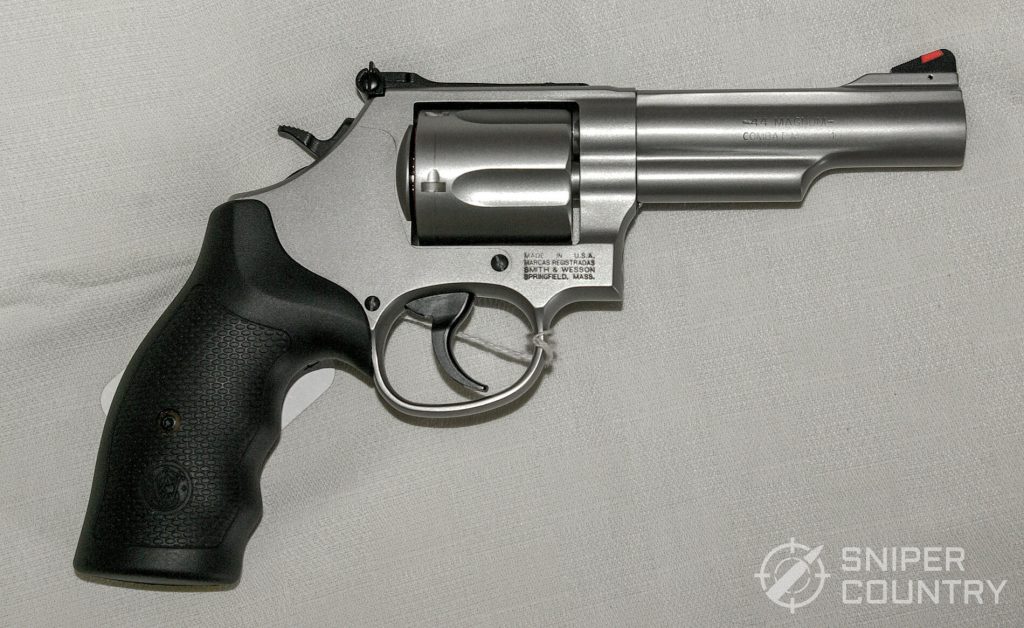
There is a Model 69 that is pretty much a twin of the 66 except you lose one round (from 6 to 5) but the overall length and price are the same.
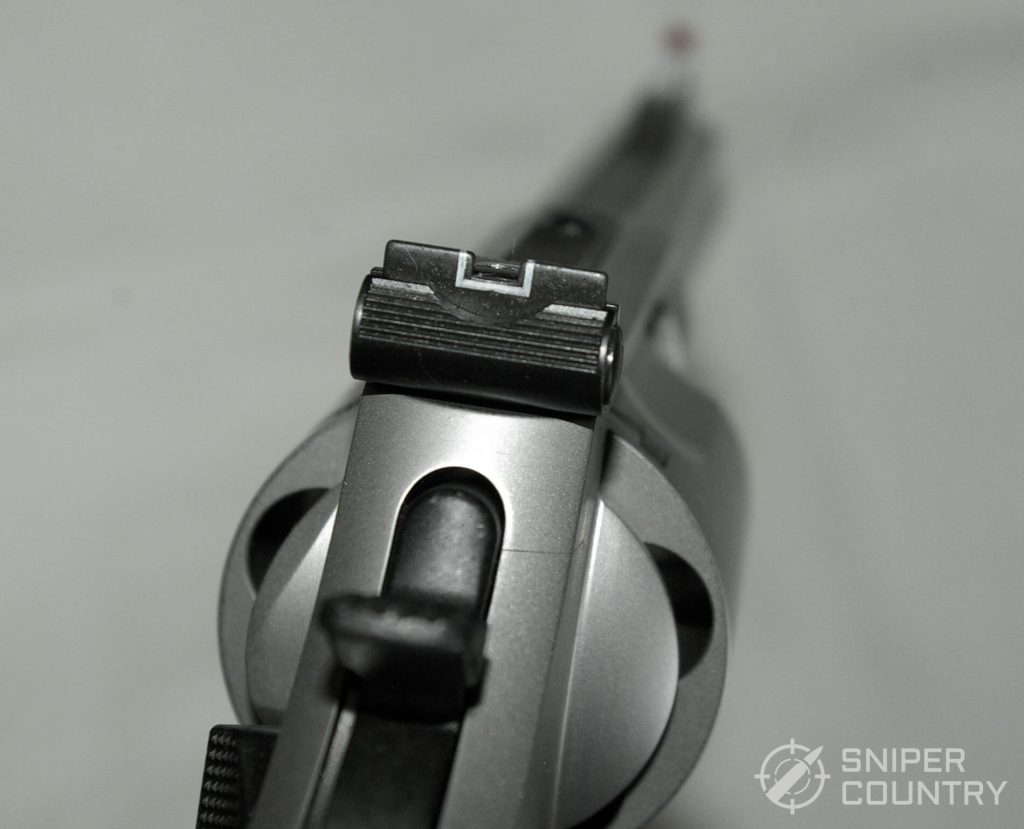
The Model 69 weighs just about an ounce more, for what that’s worth. A pretty good system, in my opinion.
If you wanted a concealed carry piece that would definitely end the argument or a trail gun that would be protection against most any critter this side of the Mississippi, here’s your gun. At 33 and a half ounces, it’s no featherweight but is definitely packable with a good belt and holster or a shoulder rig. Load the first couple of chambers with .38 Special shot shells if you’re in snake territory and the other four with a hard-cast 160-grain semi-wadcutter at 1,000 fps or so and you’re ready to go. This little guy is truly a gun that can be what most of us who tramp the woods and fields need in a sidearm. Check one out – you won’t be sorry.
Colt Python
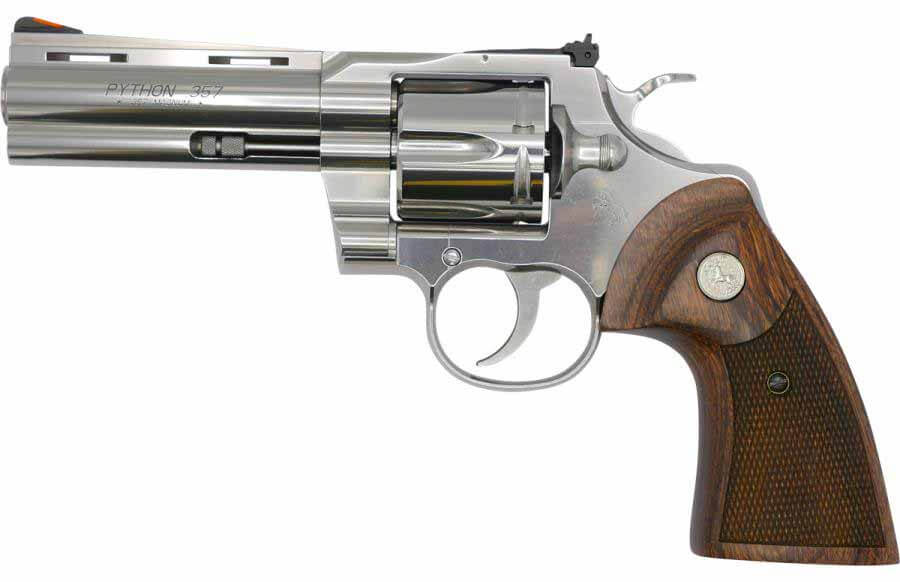
The new version of the Colt Python is a beauty. Polished to an almost mirror-like sheen, this pistol is one that collectors salivate over, in its original form. Introduced in 1955 and in production until October of 1999, the Python was the most popular “snake gun†that Colt made. You could still get a Python from the Colt Custom Shop until 2005, but then production was ceased totally. Fast-forward to January, 2020 when Colt confirmed rumors that the veteran Rampant Stallion snake gun was to be produced again. Available with a 4.25- or a 6-inch barrel, the gun looked an awful lot like its predecessor but had some internal changes made. A very few of the new guns were plagued with a few issues that required the gun be sent back to Colt for repair. Consequently, the gun garnered many comments on various gun websites. I believe these issues have been resolved and the gun is selling very well. If you want one of the true “jewels†of the revolver world, check out the Python. When it was brought out in the mid-20th century, it was referred to by more than one gun writer as the finest production revolver made. I think there are adherents today who might say the same thing.
Kimber K6
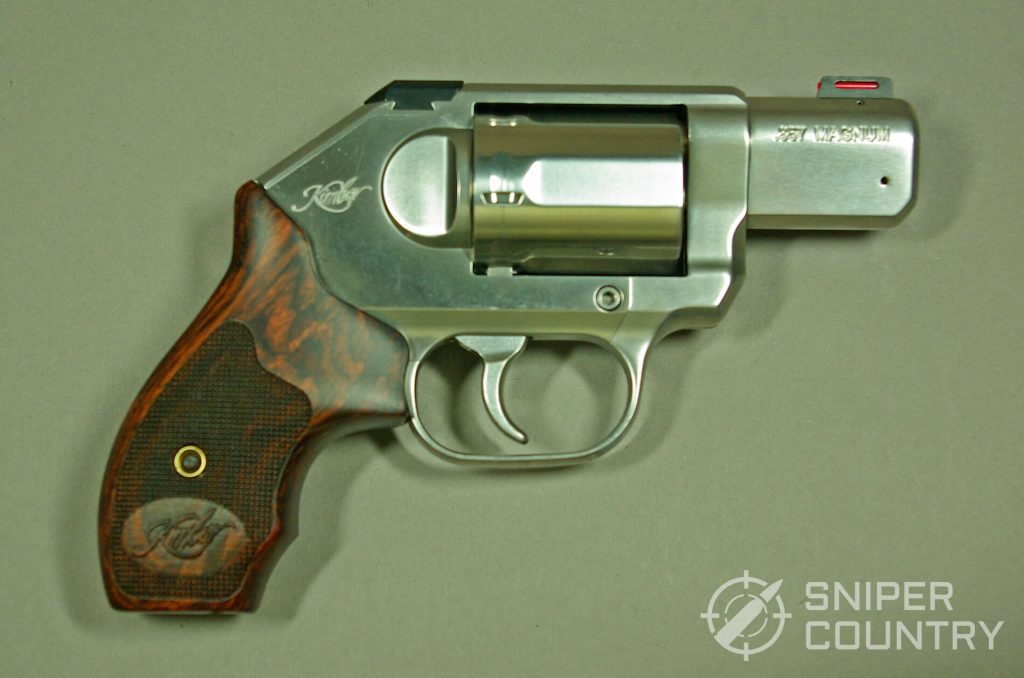
The Kimber K6 revolver was a surprise when it was introduced in January of 2016. The company was known for its rifles and semi-auto handguns. (I reviewed one of those. Go here for that review and a bit about the history of the company). The guns are recognizable as Kimbers by the semi-flats cut on the cylinder.
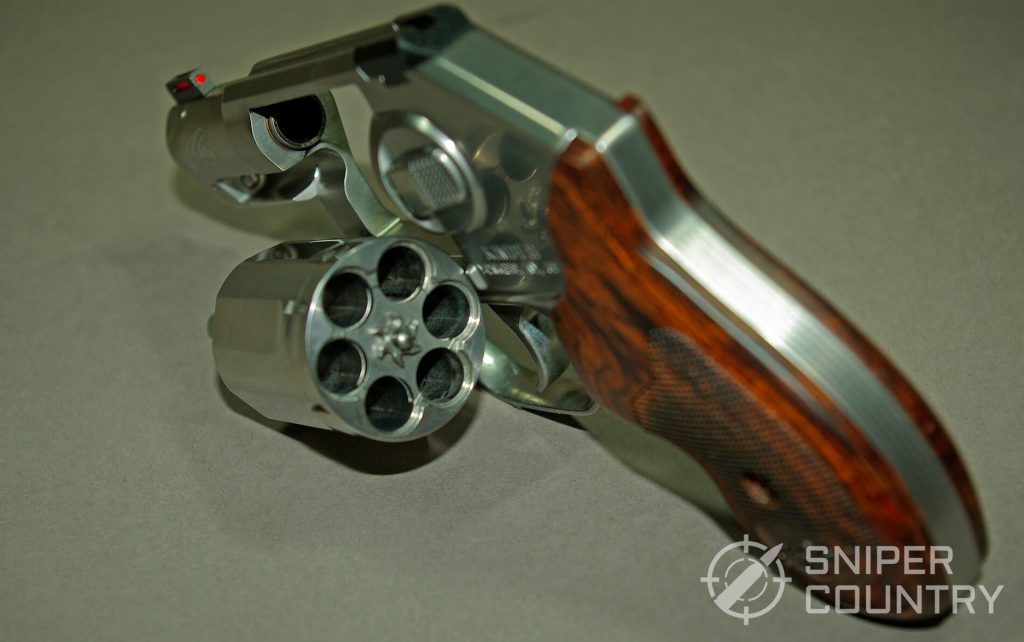
The front part of each chamber is flat, with the rear portion round.Early models used a hidden hammer and were double action only, but the company expanded into models with an exposed hammer that used the traditional DA/SA style of firing. Fit and finish are excellent, as it typical with most guns Kimber makes. Another plus is that these guns are six-shooters, not five. Additionally, if you want an adjustable rear sight and longer barrel, different grips, a satin finish, four-inch target gun or other variation, you can get those features in different models that Kimber offers. The K6 line has proven to be well-made guns and are very popular.
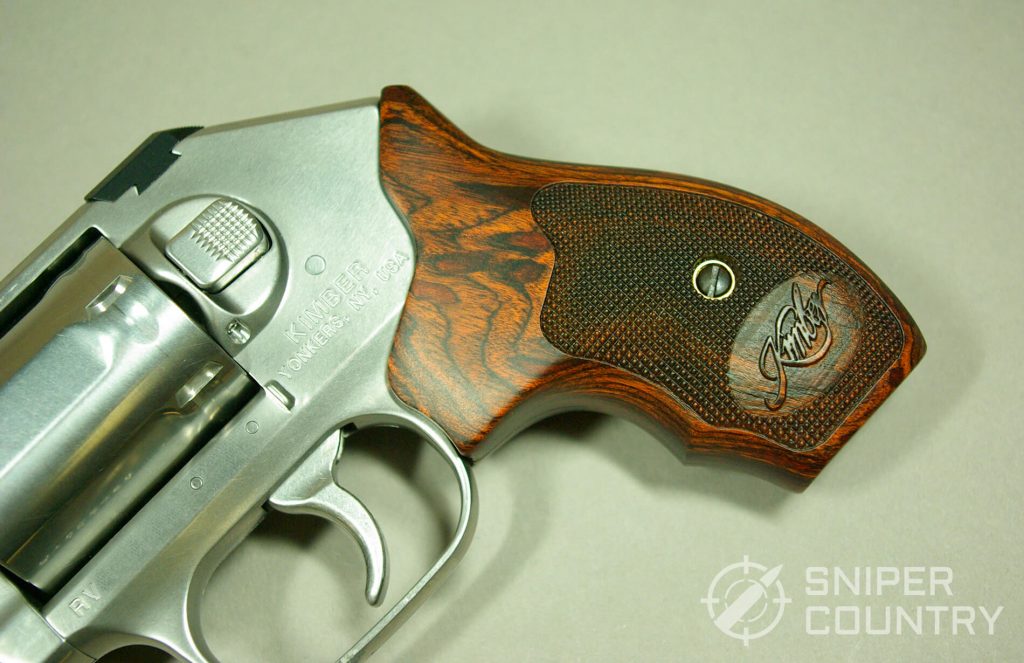
BONUS OFFER: Get your free shooting range targets to print at home!
Get your free targets to print at home!
The .44 Special
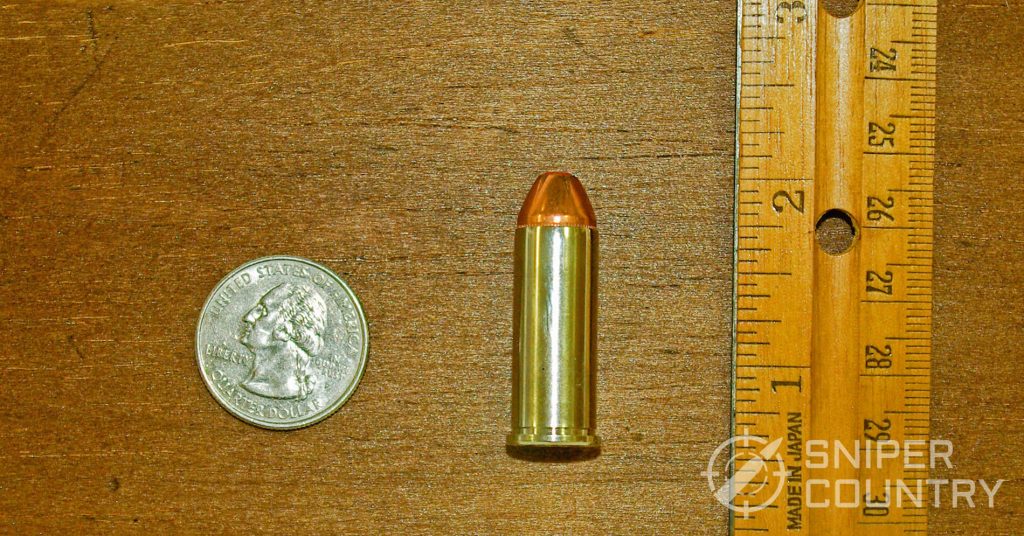
Uses: Hunting, Fun Shooting, Home Defense
We now come to one of my favorite revolver calibers. The .44 Special has been around since time began, it seems, and is one of the truly great cartridges. Based on a lengthened .44 Russian case, the round was known for its great accuracy from the very beginning. The standard factory load for years pushed a 240-grain soft lead bullet at anywhere from about 650 – 750 fps, depending on the gun. Modern loads incorporate expanding bullets at velocities only dreamed about when this round was young.
Versatility Is Its Middle Name
If I had the ability to re-name this cartridge, I would suggest adding the V-word as its middle name. The .44 Special has been used to put down more game over its long history than many could imagine. Originally designed as a round that could be shot as a gallery load (slow target load), it gained much respect when Elmer Keith experimented with it in the 1920s and 1930s and made his results known. Elmer was the outdoorsman’s outdoorsman. Living in the west, he hunted most every type of game available and was one of the first to experiment in depth with ballistics, using both rifles and handguns. Never satisfied with what he considered anemic factory loads, he was always on the trail of hotter hunting loads for his guns. He originally tried boosting the venerable .45 Colt’s velocities using his hard-cast semi-wadcutters but the old cowboy round wasn’t up to the task due to the way brass was constructed at that time, with the primer pocket protruding into the bottom of the case, thereby weakening the case head. The balloon-head (as it was called) case was not able to be hot-rodded, and that’s about all that he could find in .45 Colt at that time so he switched to the .44 Special. His “signature loadâ€, if there was such a thing, was a 245-grain semi-wadcutter at 1200 fps out of revolver. He blew up some older, blackpowder-era guns in the process. Cut to 1955 and Elmer’s involvement with Smith and Wesson and Remington. His famous .44 Special thumper load was well-known as a handgun hunter’s go-to round for deer-sized game. The problem was that guys were trying it in older guns as mentioned above, so Elmer, S&W and Remington got together and decided to lengthen the case about 1/10 inch to prevent it from being inserted into an older gun’s chambers. (This is basically how the .357 case became longer than that of the .38 Special – to keep the Magnum out of Special chambers). The first commercial .44 Magnums were introduced in 1956, but we’re getting ahead of ourselves.
Let’s look at a gun or two that fires only the .44 Special.
Charter Arms Bulldog
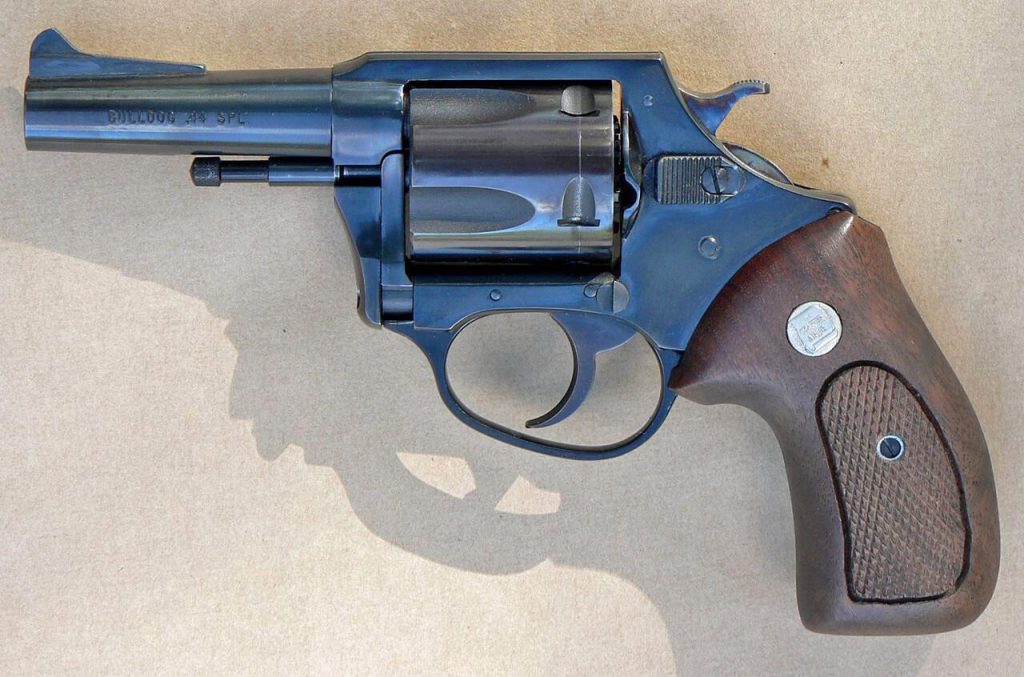
Charter Arms is a company that I’ve talked about before…you can read a bit about it here. As I said there, the company was founded by Doug McClenahan in 1964. Doug had worked for several gun manufacturers but had his own ideas about how a snub-nosed revolver should be built. One of his first products was a three-inch-barreled .44 Special he called the Bulldog, a generic term used to describe the British short-barreled revolvers of the 19th century. Those guns so-named shot a large, heavy, slow-moving bullet and were fairly easy to conceal. His gun had walnut grip panels, fixed rear sight and no protective ejector rod shroud. The gun sold fairly well, and he expanded the line into different calibers. The .44 Bulldog’s claim to fame, if you could call it that, was its use by David Berkowitz, A.K.A. “Son of Samâ€, in a series of murders of couples sitting in parked cars in New York in the 1970s. As usual, the press jumped on the tool he used to accomplish his heinous crimes and vilified the gun and the company that made it. How do I know all this? Well, there IS Wikipedia, of course, but I lived it – I was a teacher back then in a tiny rural school who owned the same model gun he used to commit his murders. It made a great carry gun, in a belt holster. A five-shooter, it was accurate with my appropriate handloads (I owned a .44 Magnum Super Blackhawk at the time for hotter loads). I remember riding around on my Yamaha 500 with the gun under a jacket, thinking I was invincible. Ah, youth…It shot a 245-grain semi-wadcutter at around 700 fps, plenty good enough for self-defense. It was a nice gun.
Alas, the company went through a few owners over the years that allowed some questionable products out of their doors which didn’t help Charter’s reputation. The company has righted itself and has been stable for a number of years. I wish I had the current version of the .44 Bulldog, a stainless gun with rubber grips and full-length underlug, although for nostalgia, I might consider buying the re-introduced original Bulldog that Charter sells. It costs a little more, but can you place a price on good memories? Anyway, they even make a four-inch version with an adjustable rear sight that weighs about 23 ounces. Now, THERE’S a trail gun! I used to carry mine with two shotshells up first with three cast bullets following them. For woods walking, it would be great. There are many variations on the Bulldog theme from Charter Arms, including models in .38 Special, .357 Magnum and .22LR so there’s something for everyone. The updated version has a 2.5-inch barrel and carries an MSRP of $422 ($436, Classic) but can be found for $370 or so. The four-inch version would be a great choice to stick in a belt holster as I do my chores around my home, since I live in the boonies. It’s light enough to carry all day but heavy enough to handle some fairly serious .44 Special handloads. Add to that the advantage of an adjustable rear sight and you’re good to go!
Ruger GP-100
The fairly new Ruger GP-100 in .44 Special is a jewel. I picked one up and, sure enough, it felt like all the other GP-100s I’ve hefted. No one has ever accused Ruger of making an underweight gun, to my knowledge. My standard description of Ruger revolvers goes something like “over-builtâ€, “built like a tankâ€, etc. Let’s just say this gun is no different.
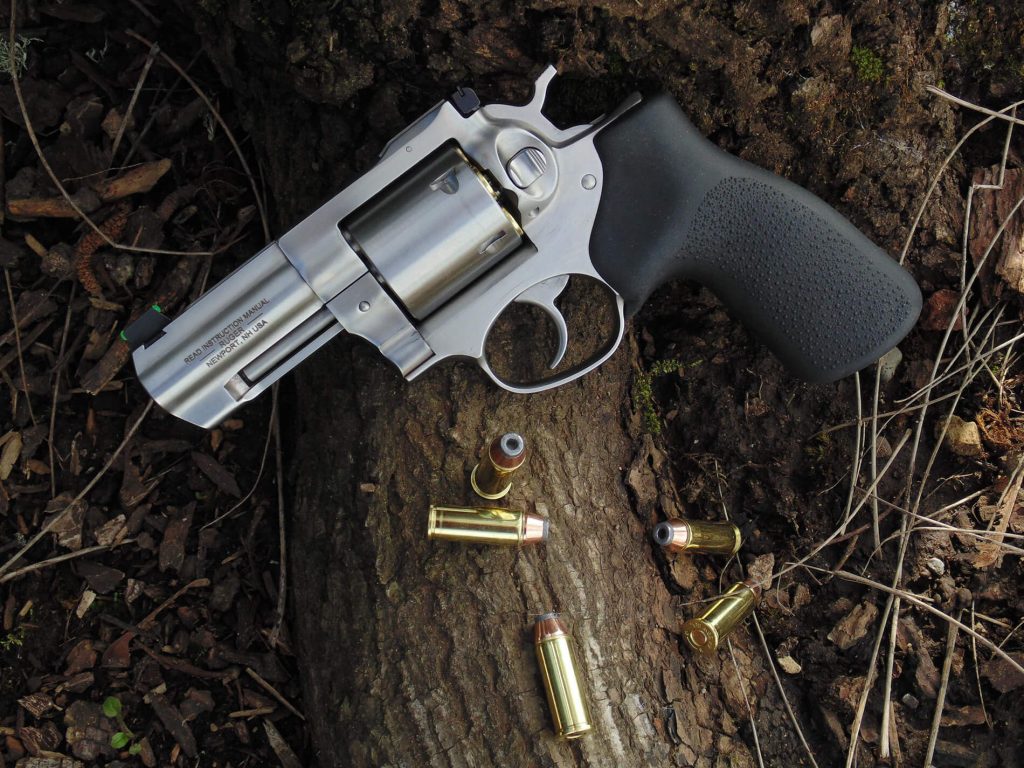
If any gun were to give the lighter Charter Arms Target Model a run for its money in terms of me hitching it to my belt to wear around my homestead, it would this one. Granted, it’s like comparing apples to oranges since the Charter Arms gun is built for carry and lighter-duty usage while the Ruger could probably drive 16-penny nails into a 2X4. They are different guns, for different purposes. It has a three-inch barrel and weighs 36 ounces, almost a full pound more than the Charter. It also has an unfluted cylinder, excellent adjustable rear sight and a fiber-optic-equipped replaceable front sight. Ruger has made .44 Specials in the past, but most of them have been single action Blackhawks. This is the first GP-100 I know of that has been chambered in this caliber. The MSRP on this gun is $829 but I’ve seen them around $650 or so.
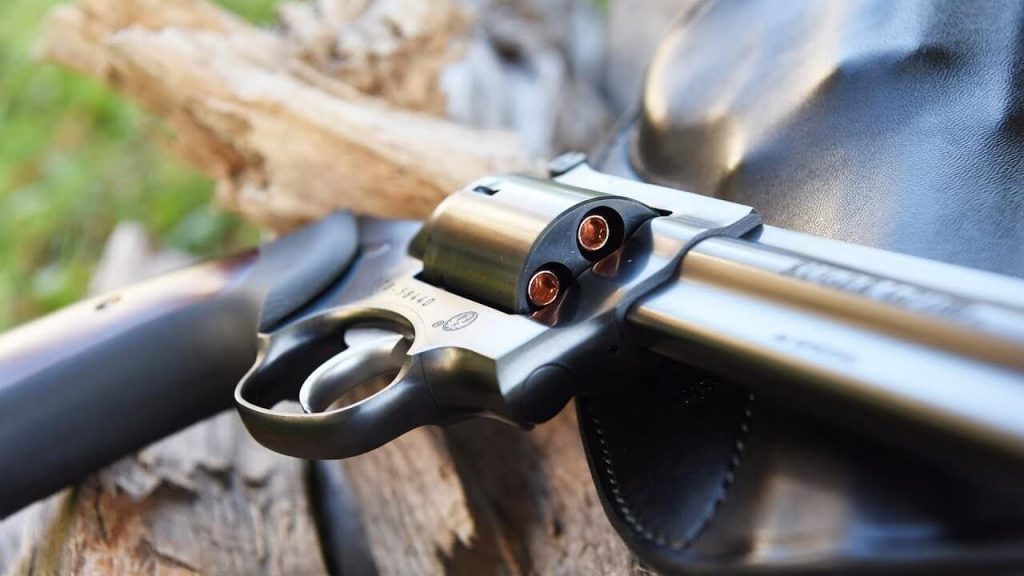
The barrel is too short to allow this gun into the hunting woods in any other role other than a back-up (at least in my state). I can, however, see some folks carrying it concealed. You’d need a good belt and holster, but it would be doable. The old .44 Special is alive and well, with more guns and ammo choices now than at any other time in its storied history.
The .44 Magnum Revolver
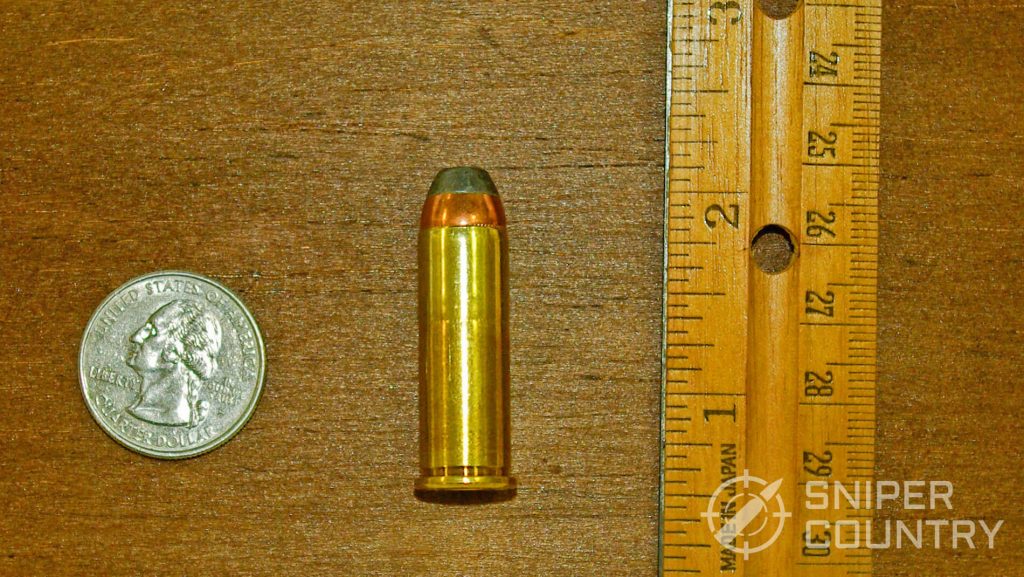
Uses: Hunting, Home Defense, Competition, Whatever Else You Want To Use It For – Who’s Going To Argue With You?
The king of the magnum hill, the venerable .44 Magnum has an interesting past. For more detail on its origins, see my article on the .44 Magnum elsewhere on this site. Suffice it to say that Elmer Keith was instrumental in its development and he had hunting large game in mind when he helped develop it. You have to know a little bit about Elmer – he was quite a hunter and liked big calibers. A .338 rifle was one of the smaller guns he liked to use. So, when it came to revolvers, it’s only natural that he wanted to “go big or go home.†After its commercial introduction in 1956, some Model 29s were sold by S&W to dedicated handgun hunters but it really wasn’t until the “Dirty Harry†movies in the early 1970s that the gun’s sales went through the roof. I’ve mentioned elsewhere in my article about the .44 Magnum that it wasn’t unusual at the time of its introduction to see the Model 29s slowly get sold out of the shop’s new gun case only to re-appear as a used gun, complete with holster and a 50-round box of full-tilt ammo with six empty cases. The owner shot six and that was enough to convince him that maybe this caliber was too much of a good thing. As the years went by, more and varied loads were produced that helped tame its prodigious recoil. I remember when Remington brought out a lead 240-grain bullet .44 Magnum load at 1,000 fps. and how much attention that product release got. This was the load that would’ve kept a lot of those 29s out of the used gun case. So, what do we have in terms of a couple of .44 Magnum guns that might fit our budget/more expensive price criteria? Let’s look at a couple of guns.
Taurus Tracker .44
![]()
I really like this gun. Available in stainless or matte black, it features a four-inch barrel boasting 8 ports (4 on each side of the front sight), a 5-shot cylinder and Taurus’ “Ribber†grips that do help somewhat tame recoil.
![]()
Add into the mix an adjustable rear sight and a 34-ounce weight and you have a very useful gun to take with you into the wild.
![]()
Would I fire a steady diet of elephant-stomper loads through this gun? Of course not. I don’t fire those loads through my much-heavier S&W longer-barreled S&W 629, let alone a 34-ounce 4-incher. I see this gun performing as a hiking/hunting companion with full-power loads shot sparingly, but also as a range/informal steel shooting/target/defense gun with mid-range loads. The gun is also available in .22 LR, .17HMR and .357 Magnum.
![]()
Taurus Raging Hunter
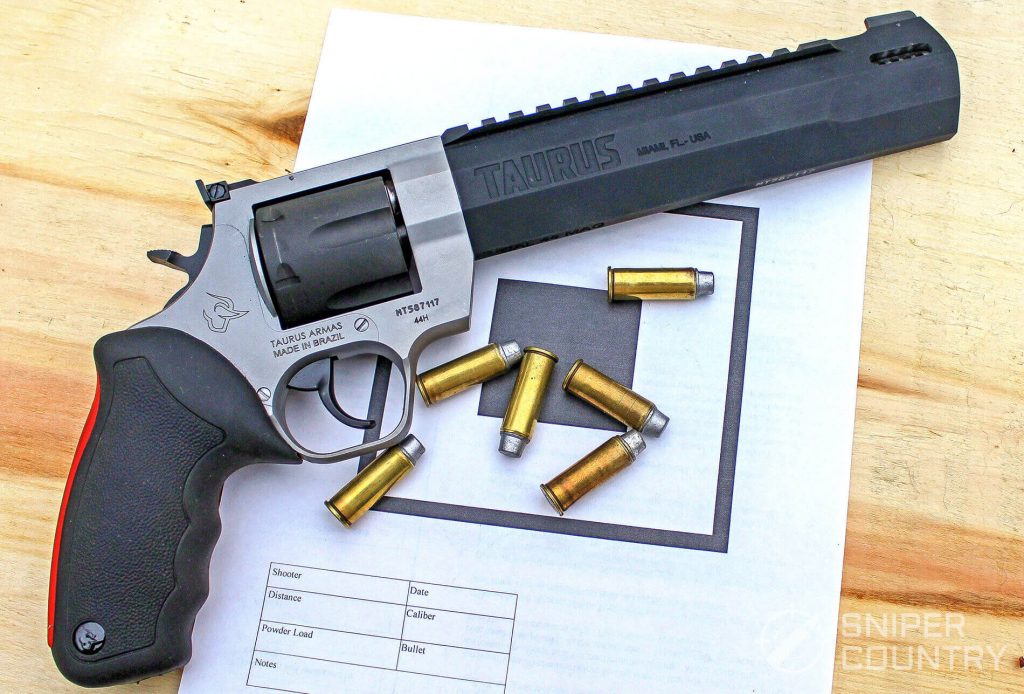
I had a fellow today tell me, as we talked in my friend Duane’s gun shop, that he had owned several Smith and Wesson 629s and other models but he like his Taurus Raging Bull best of all and considers it the best .44 he’s owned-and he’s had several. The Raging Bull has been, or is in the process of, being discontinued in favor of the Taurus Raging Hunter. We shall take a quick look at the Hunter.
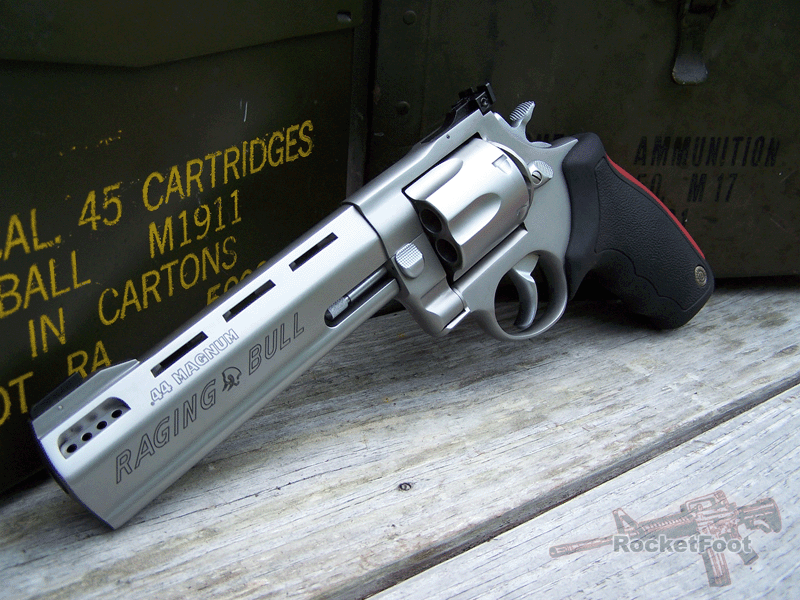
One of the features my friend likes about his Raging Bull is its ported barrel which was carried over from the Tracker into both the Raging Bull and the Raging Hunter. He must be careful about recoil, being able to shoot with only one hand so he knows of which he speaks in terms of recoil reduction. The recoil reduction offered by the ported barrel is enough to make that porting desirable. (I remember the Mag-Na-Port ads from the 1970s…it was one of the first nationwide after-market barrel porting companies. They’re still going strong.). The blast may be a little more pronounced and those of us who shoot cast bullets may have to take an extra minute or two to keep the ports clean, but it’s all worth it… the recoil reduction the ports offer must be experienced to be appreciated. One feature that doesn’t get a lot of mention on the Hunter model is the cylinder lock on the frame’s left side just ahead of the cylinder. This is similar to the cylinder release on Dan Wesson revolvers and provides yet one more lock to keep the cylinder closed until you want it open. You must release both this and the traditionally-placed cylinder release in order to open the cylinder. The Tracker and the Raging Hunter are great guns for the money.
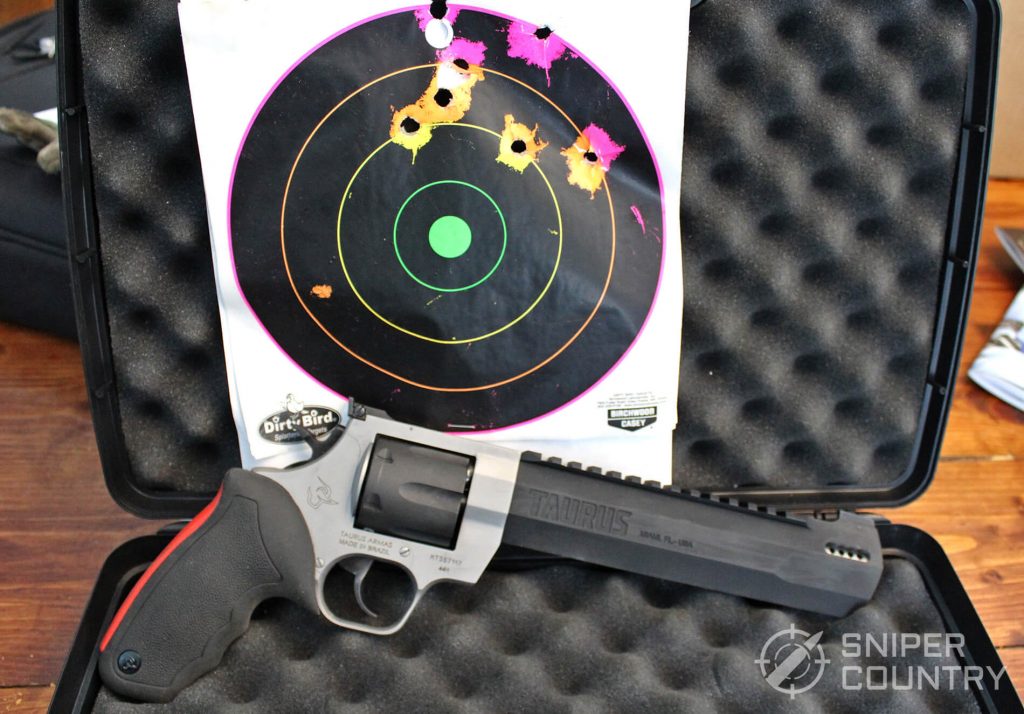
S&W 629
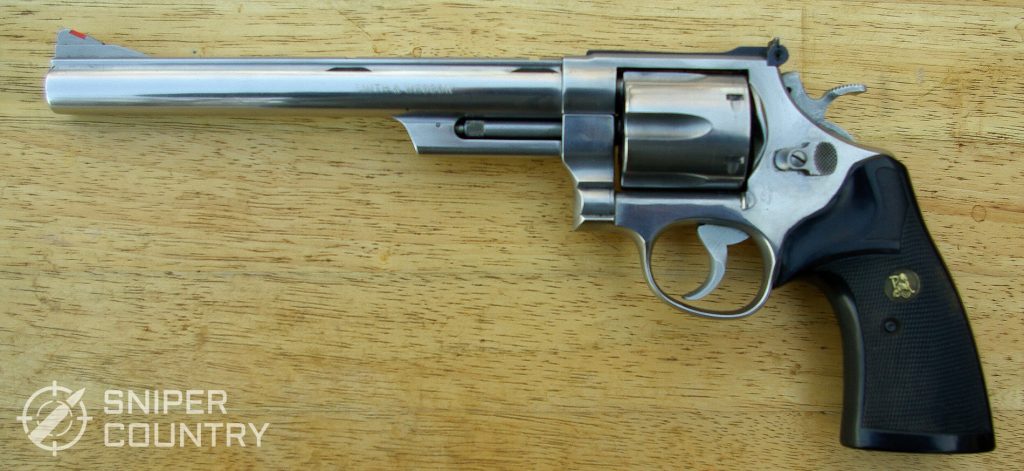
I couldn’t write about the .44 Magnum without including my 629 with the 8.375†barrel. I’ve written about it before, in my .44 Magnum article, but I need to mention it here. This not a gun that’s off the beaten path, but it is worth a mention as the other end of the budget/more expensive gun duo pattern that I’m trying to stick to. There are many more-expensive .44 Magnums out there, including several by Smith and Wesson, but I’m intimately familiar with this 629 and it will suffice in its given role.
I have hunted deer with my 629 and have been largely successful. It is a fine target gun with lighter loads, and even works on squirrels without turning them inside-out. As I have stated before, I tend to not load to maximum levels, especially the older I get. I figure if it hurts to shoot then it ceases to be fun. The arthritis my hands are beginning to exhibit tends to dictate the pressure levels of my loads. Having received a new 240-grain bullet mold for Christmas, I’m off to the load-experimentation races again. (I mentioned above how revolvers have the advantage when you’re working up a new load-here’s proof of that). So far, I’ve had good luck with, among others, the shotgun powder Hodgdon Long Shot.
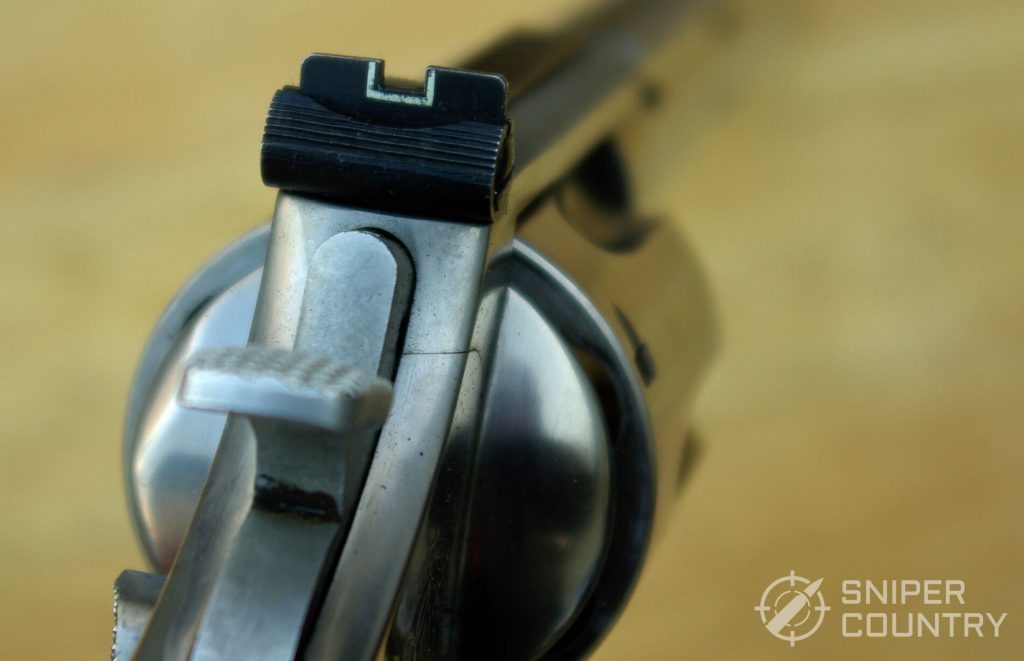
It works well with my handguns. Why mention this? To prove that my old (my 629 was made in 1982), long-barreled, “obsolete†revolver is still relevant in today’s shooting world.
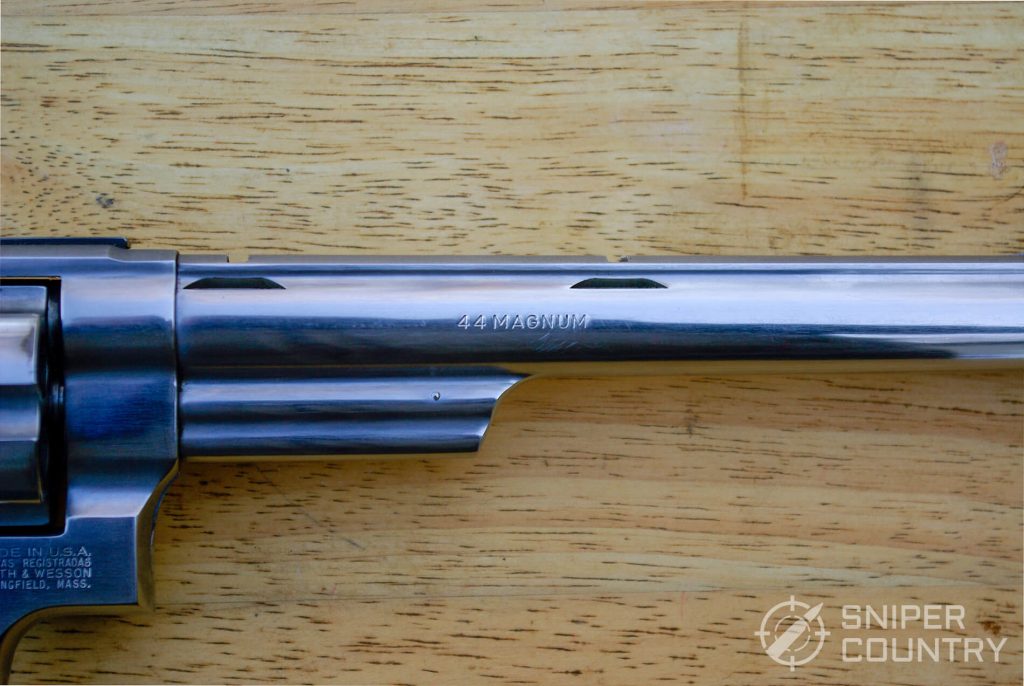
There are many .44s out there that handle hot loads well, so if you are looking to get a gun to shoot those loads you might want to consider a Ruger Super Blackhawk, Taurus Raging Bull, or other heavily-built revolver. Will my 629 handle those loads? You bet – it’s just that I can’t handle them like I used to. There is another reason – the 29/629 may get out of time or have the cylinder gap shorten a bit with continued use of such loads and need a trip back to the factory, but that’s a moot point. If you want to shoot moose-thumpers, shoot them. Just put some lighter loads downrange every now and again.
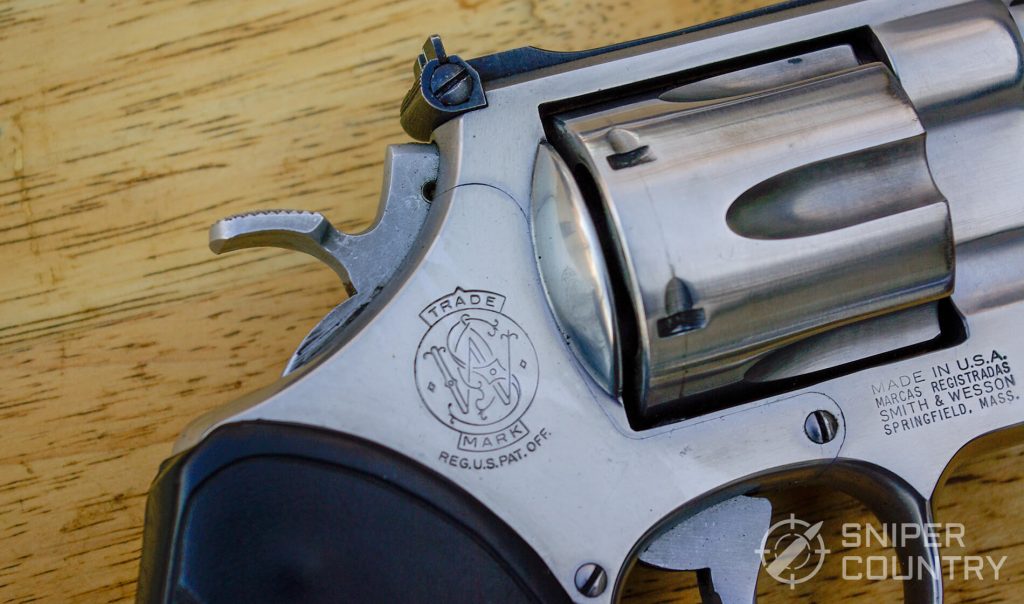
The modern incarnation of my 629 has a 6-inch barrel (I assume you could get a longer one through the Performance Center) but keeps the partial underlug that doesn’t go to the muzzle. I just like the look of that underlug – I understand the full-length one adds a few ounces but not enough to make a difference for me. It carries an MSRP of around $969 (depending on features, barrel length, etc.) which translates to a real-world price of around $800. What a great gun!
The .45 Colt Revolver
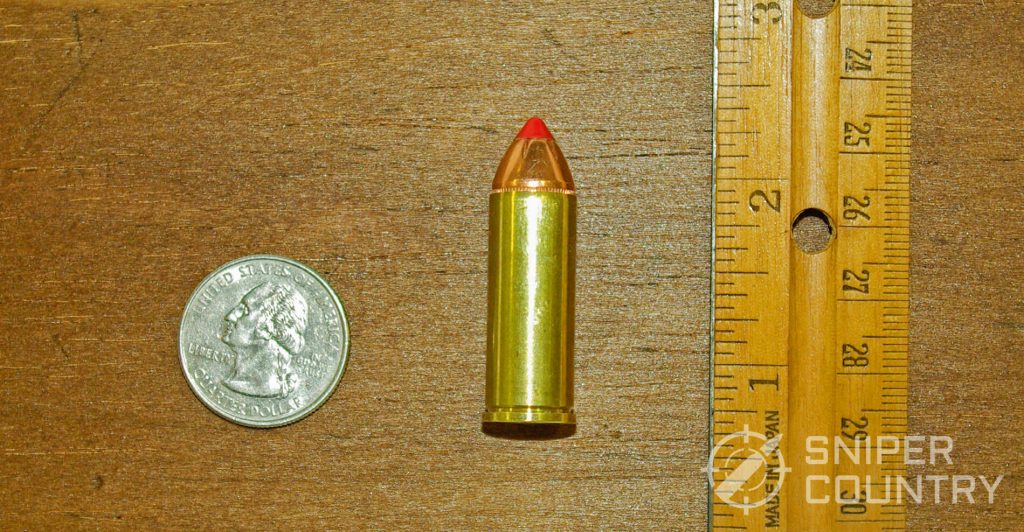
The .45 Colt made its debut in 1873, along with the Colt Single Action Army (SAA) revolver. It was a military-issue round that took the place of a rather pathetic .38 caliber cartridge that lacked stopping power. The “new†.45 pushed a 255-grain round-nosed, flat-point lead bullet out of a 7.5-inch-barreled SAA at around 900 fps. This was a decisive improvement over the older .38 round. It proved effective for the Army and was issued widely. Interestingly enough, it was not chambered in lever-action rifles at that time. The most popular lever rifle round of .40-plus caliber bullet was the .44-40. You could get revolvers in the same chambering and only have to carry one type of ammo. We now have many fine carbines chambered in .45 Colt – I’ve killed deer with mine – and many revolvers, but I’m going to depart from my practice of mentioning at least two guns for each caliber (except the .38 Special) and zero in on just one…a Ruger Blackhawk.
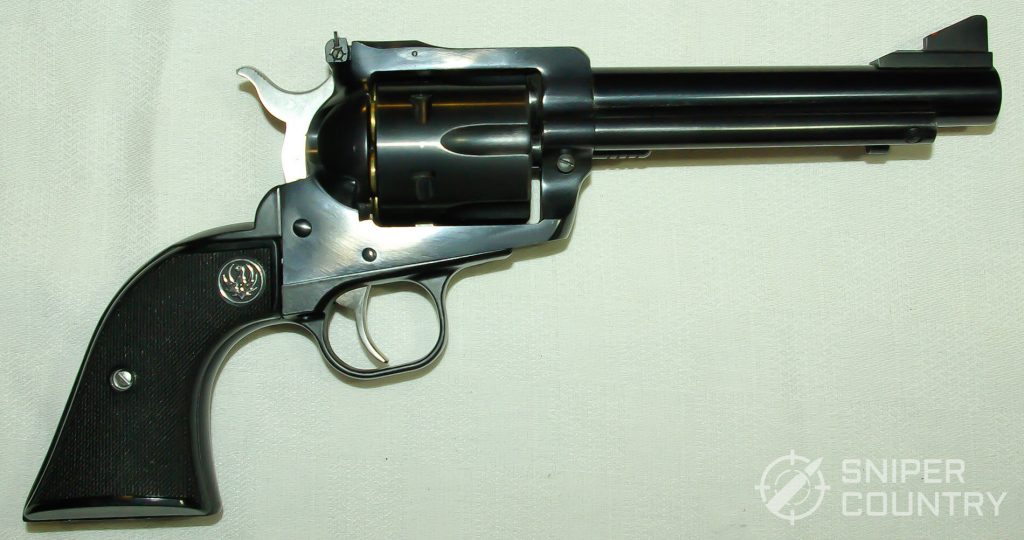
There are a few double action revolvers out there that chamber the .45 Colt and many, many SAA clones. There is nothing at all wrong with those guns. I just like the Ruger Blackhawk in this caliber, as I happen to own one and I tend to write about guns with which I’ve had some experience. You could do a lot worse than to have a double-action revolver chambered in .45 Colt as a defense weapon, personal or home.
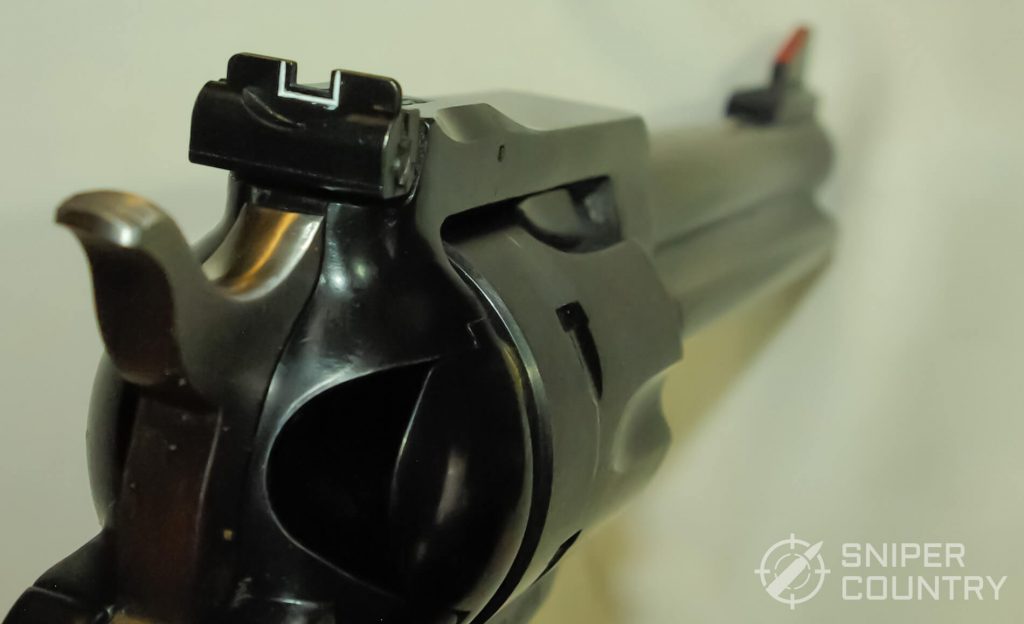
Ruger Blackhawks are built very strongly. I figured this out 40 years ago, when I owned my first one. That one had a 7.5-inch barrel and was a joy to shoot. My handloads at that time were stout, but nothing like what I’ve come up with more recently to fire through my 5.5-inch model. With the right bullets and powders, loads that rival the .44 Magnum can be put together in the right .45 Colt. I think I’ve gone full-circle, though, as I’m back to loading so-called “normal†loads for it. The others just hurt to shoot, especially with the factory grip panels. Hogue one-piece grips help but are very bulky. You know the gun is stronger than some others when you look in a reloading manual and you see “Ruger-Only†.45 Colt loads. As with the .44 Magnum, I’ve killed deer with this gun and my home-cast bullets and handloads. The advantage that modern .45 Colts have is that most of them have a groove diameter of .452 inch, which allows the use of bullets designed for the .45 ACP.
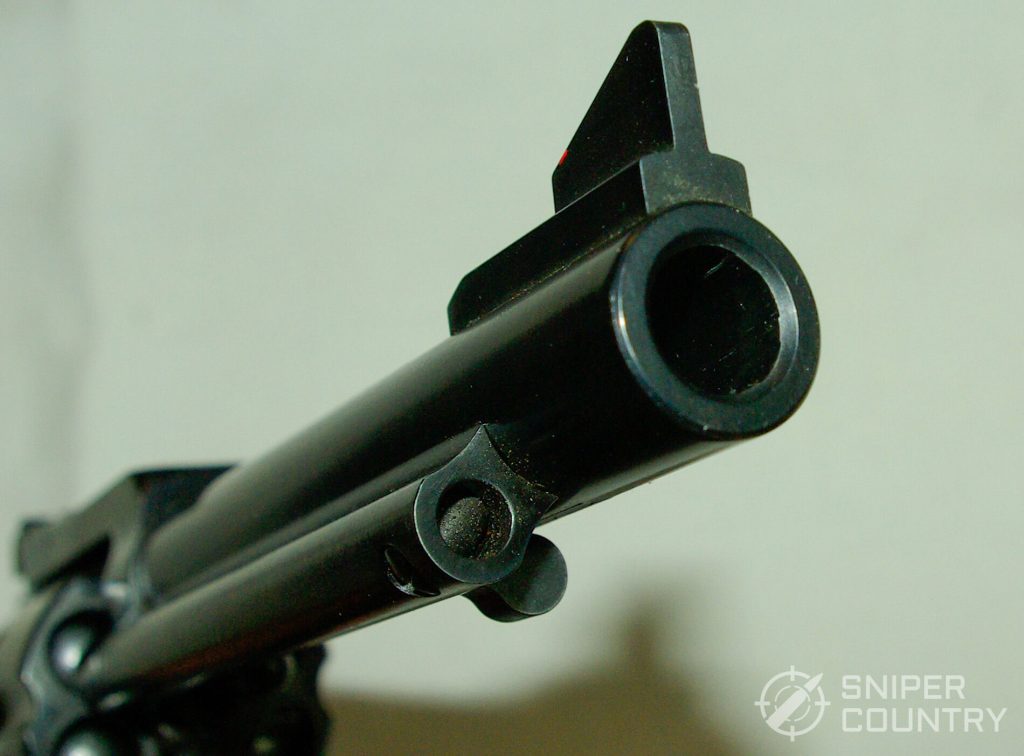
I’ve shot some of the lighter .45 Auto bullets with decent results in my Blackhawk. If you have a newer .45 Colt (some of the older ones have a .454 groove diameter) and are a reloader, give the lighter bullets a try. They are easy on the hand and the gun. A Blackhawk like mine carries an MSRP of $749. It’s a convertible model with an extra .45 ACP cylinder. Without that, the price goes down to $669 in blue. Real-world pricing has the convertible, blued model around $575 with the non-convertible around $500. Stainless is available at a slightly higher cost.
Cimarron Pistolero
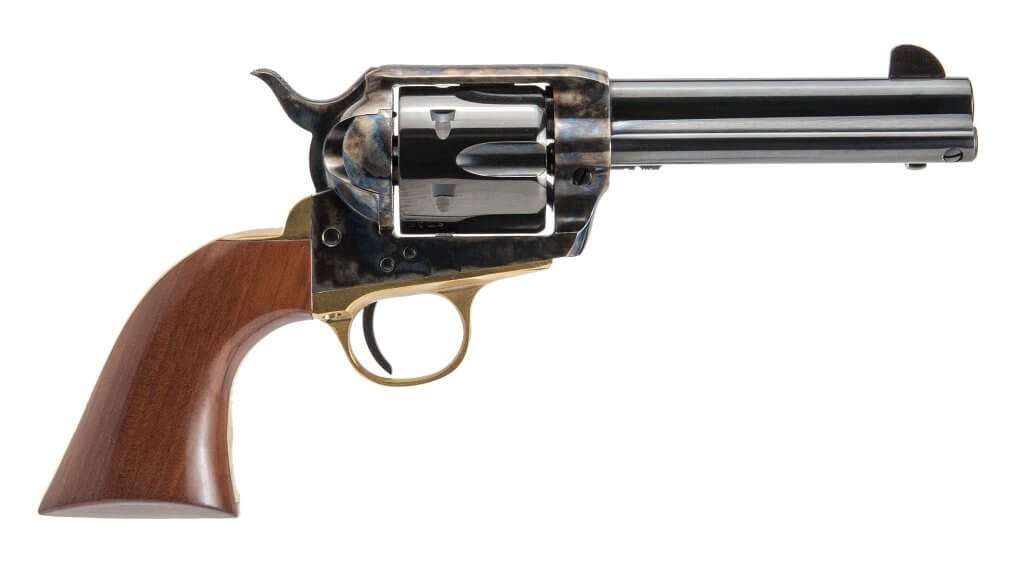
The Cimarron Pistolero would have you think that you’re standing next to Matt Dillon as the “Gunsmoke†credits scroll across the TV screen. It is about as faithful a copy of an 1873 Single Action Army as I’ve seen, right down to the color-casehardened frame.
If you want a brass frame or one in plain blue, there are many other models out there that you can get. I handled one of these just recently (it had been a good while since I’d had one in my hands) and was struck by how well-balanced the gun was with its short 4.75-inch barrel. This gun would be just about perfect for cowboy competition or just plinking. It’s like picking up a piece of history, even though it’s a reproduction. Made by Italian gun made by (near as I can figure) Uberti. Pietta is another manufacturer of 1873 clones, among other models. Either way, you end up with a very well-made gun for the money. My buddy Duane sells a lot of Cimarrons at his gun shop and is happy with their quality. For all you cowboys and cowgirls out there, here you go!
Conclusions
So, what can we draw from all this? My main goal was to keep the idea alive that revolvers are still a viable option if you are looking for a new gun. Just remember that they are used differently than semiautos, and can be great “mobile experimental ballistics labs.†If you’ve never shot or owned a revolver, you owe it to yourself to at least give one a try. It’s amazing how many guys post gun-related YouTube videos who admit to having never shot a revolver. They’re missing out on some fun shooting sessions. A decent .22 LR gun is a great place to start, then work your way up the caliber ladder. I haven’t mentioned the biggest advantage that I’ve found that revolvers have over semiautos…you don’t have to pick up your brass!
Please leave a comment below if you’ve had an interesting experience with a revolver or have a question.

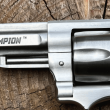



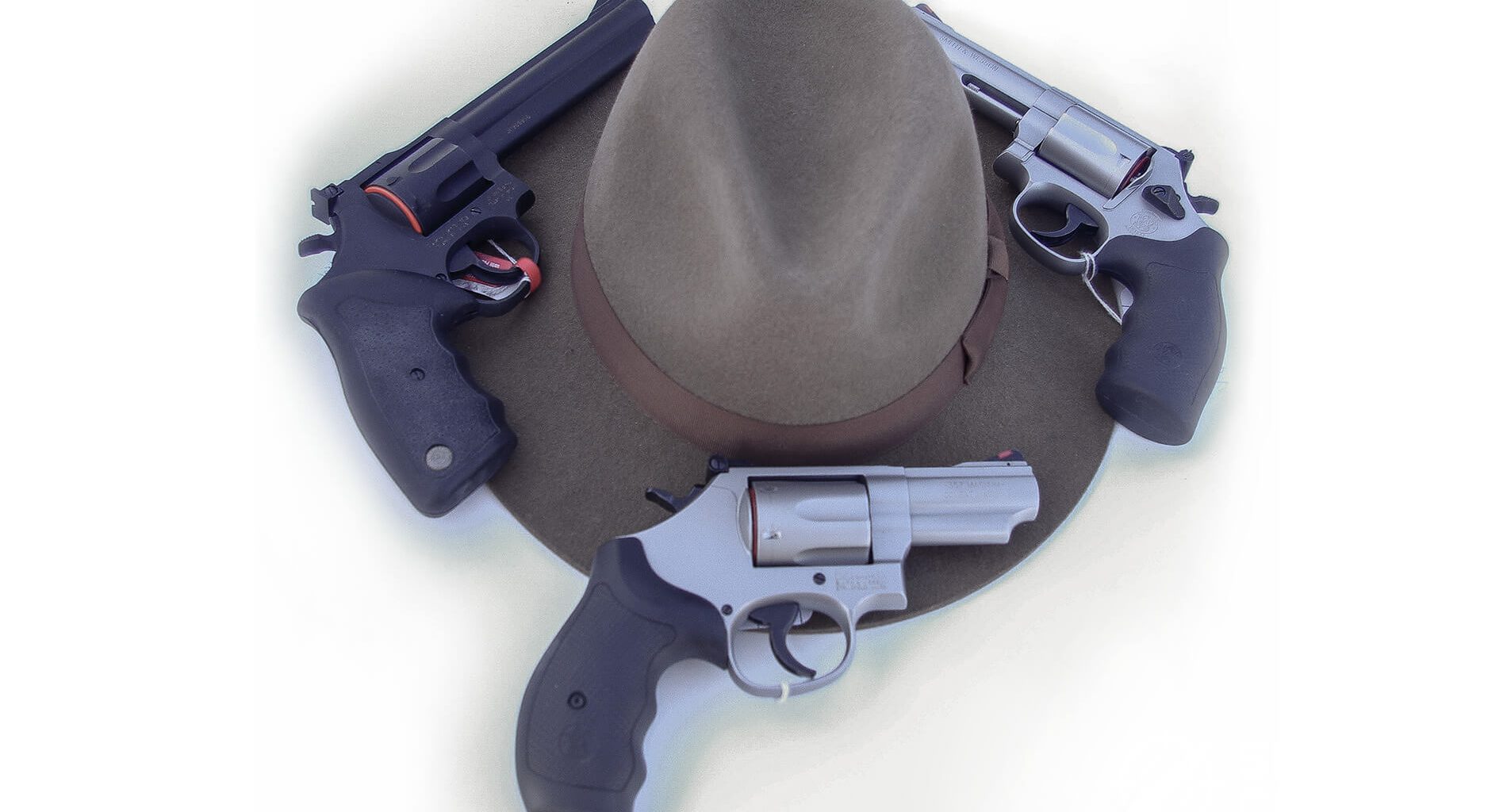
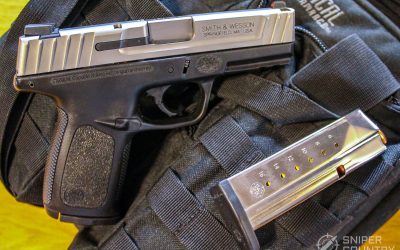

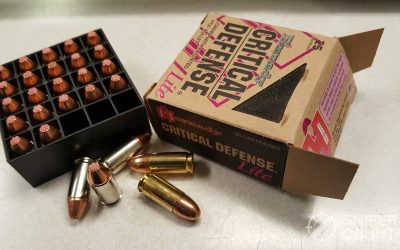
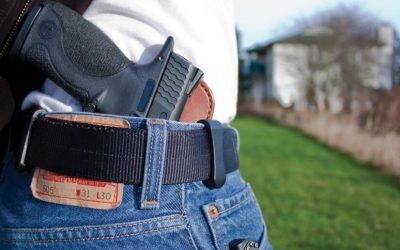
![9mm Glock Models [Ultimate Guide]](https://www.snipercountry.com/wp-content/uploads/2018/10/Glock-17-vs-Glock-19-vs-Glock-26-vs-Glock-41-vs-Glock-43-WM-400x250.jpg)
![Handgun Caliber Chart [2025 Ultimate Guide]](https://www.snipercountry.com/wp-content/uploads/2018/10/Handgun-Caliber-Comparison-400x250.jpg)
![Rifle Calibers [Ultimate Guide]](https://www.snipercountry.com/wp-content/uploads/2018/12/Header-1900-400x250.jpg)


